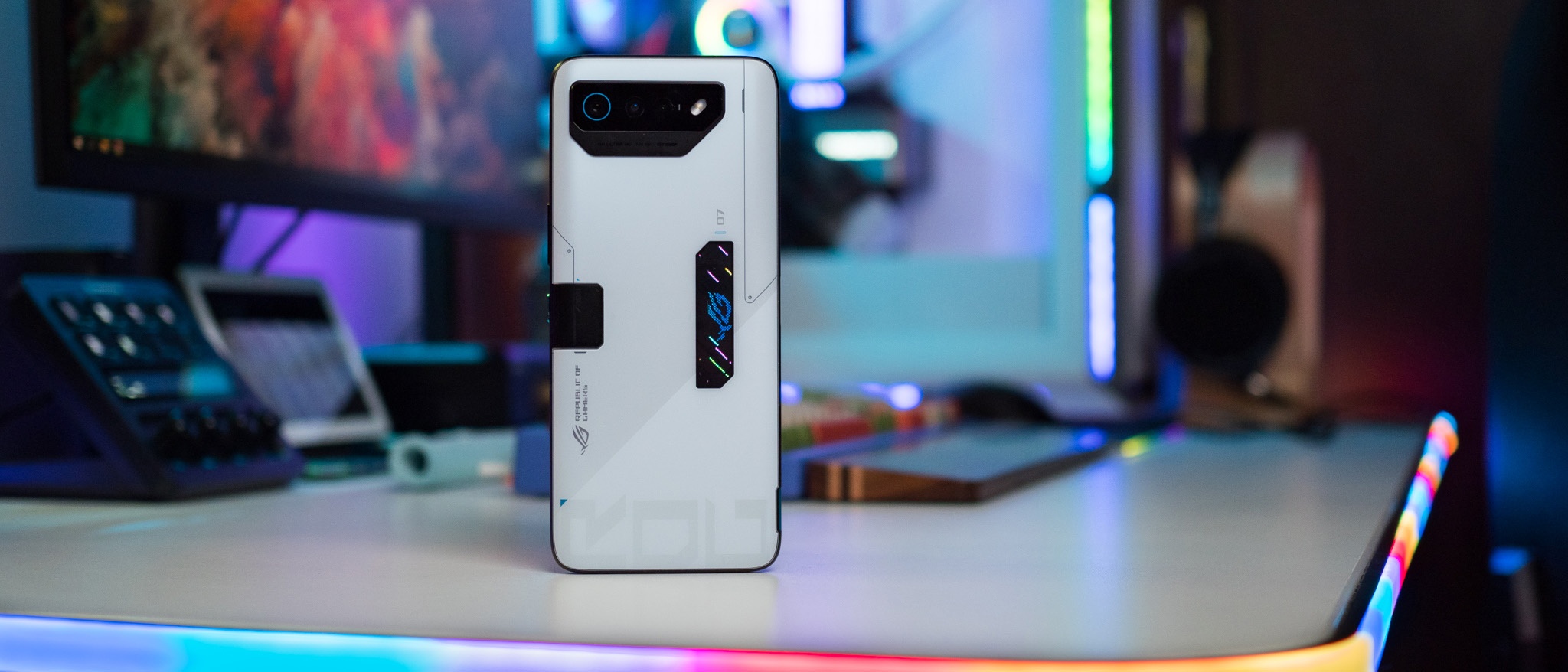Android Central Verdict
The ROG Phone 7 Ultimate isn't your average gaming phone. ASUS made dozens of changes to the underlying Android kernel to deliver the ultimate gaming experience, and that's immediately evident the moment you start using the phone. This is a phone built to blaze through visually-demanding games, and it manages to do just that. Combine that with an aggressive design, sublime 165Hz screen, astounding hardware, a gargantuan battery, clean software with more customizability than any other phone, and you get an overall package that is just marvelous. This is the fastest phone I've ever used, and if you want a flagship that stands out, the ROG Phone 7 Ultimate should be on the top of your list.
Pros
- +
Stunning 165Hz AMOLED panel gets brighter than previous years
- +
Phenomenal for marathon gaming sessions
- +
Incredible internal hardware
- +
More customizability than any other Android device
- +
Outstanding battery life
- +
The best onboard sound of any phone today
- +
Clean Android interface with no bloat
- +
Better cameras this time around
Cons
- -
Only two Android version updates
- -
Cameras not as versatile as rivals
- -
No wireless charging
- -
Costly
Why you can trust Android Central
I used the ROG Phone 7 Ultimate for just over three weeks before writing this review, and in that time, I asked myself a few times if I would spend my own money to get the phone. Coming in at €1,399 ($1,533), the ROG Phone 7 Ultimate costs the same as the Galaxy S23 Ultra, and while it has a more aggressive design and unique gaming-focused extras, it isn't aimed at a mainstream audience.
Another point against it is that ASUS will only roll out two Android version updates, which is two less than what Samsung, OnePlus, and OPPO offer. Then there's the fact that the cameras aren't as good as the best Android phones — that isn't a big priority for ASUS.
The shortcomings make it easy to write off the ROG Phone 7 Ultimate, but it would be wrong to do so. Because what ASUS has managed to create here isn't just the best gaming phone, but a spectacular overall effort that is one of the best Android experiences you'll find today. So would I part with my cash to pick it up? Absolutely.
ASUS ROG Phone 7 Ultimate: Pricing and availability
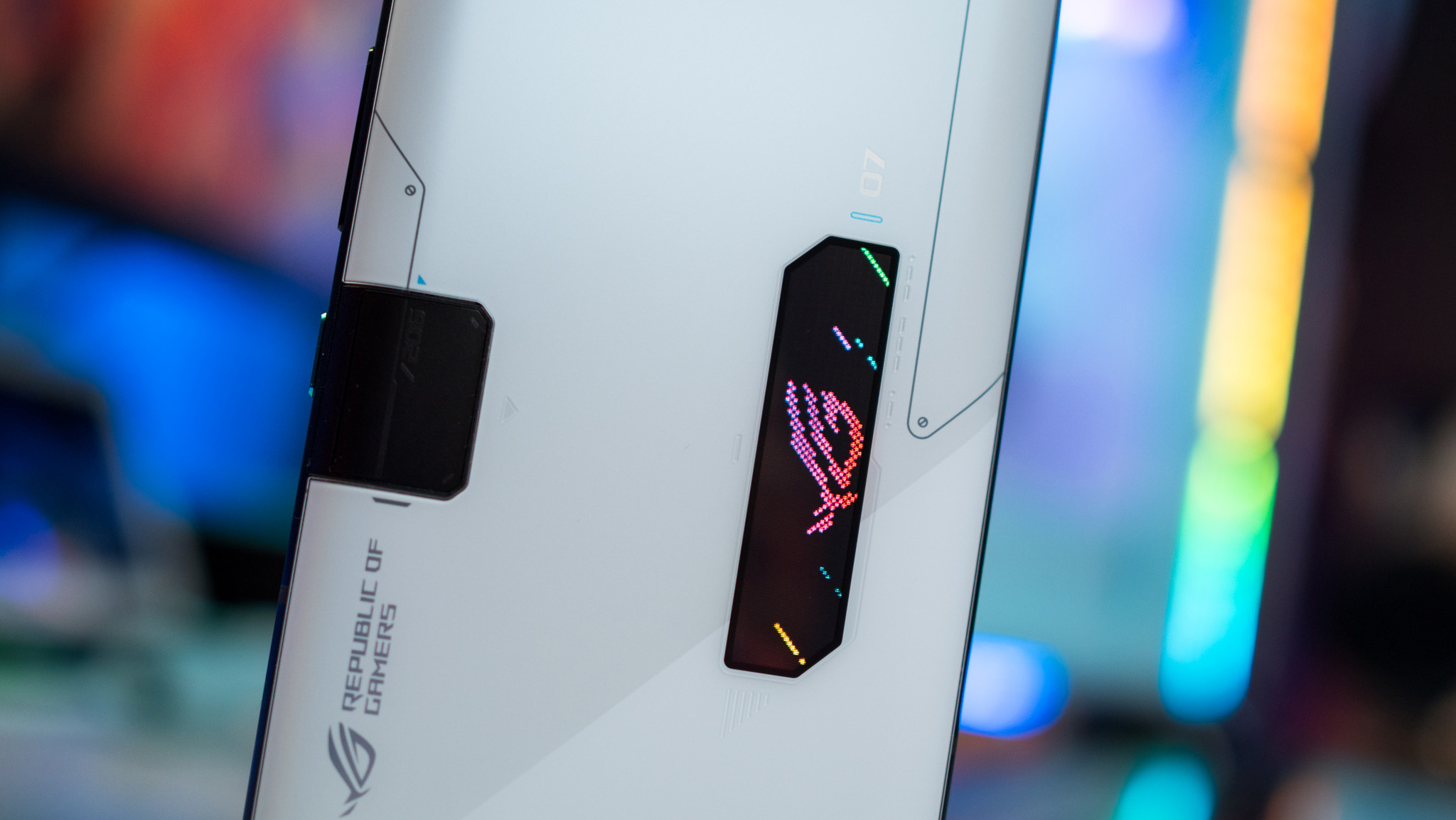
ASUS unveiled the ROG Phone 7 Ultimate on April 13, and the device is slated to go on sale in global markets in the coming weeks, with pre-orders now live in Taiwan and select regions in Europe. The ROG Phone 7 Ultimate is sold in a single variant with 16GB of RAM and 512GB of storage, and it is available for €1,399 ($1,533). What's interesting with this generation is that ASUS is bundling the latest version of the AeroActive Cooler with the package, a €110 ($120) value.
Like previous years, there's also a standard model of the ROG Phone 7 that will be debuting at €999 ($1,095). The standard version has similar hardware, but it misses out on a few extras, like the AeroActive Portal that funnels air into the chassis of the ROG Phone 7 Ultimate for better thermals. There's no Pro variant this time, with ASUS introducing just the two models in the series.
At this moment, there's no mention of when either device will be available for sale in North America. If history is any indication, the phones should debut in the region later in the quarter, but ASUS hasn't detailed availability just yet.
ASUS ROG Phone 7 Ultimate: Design
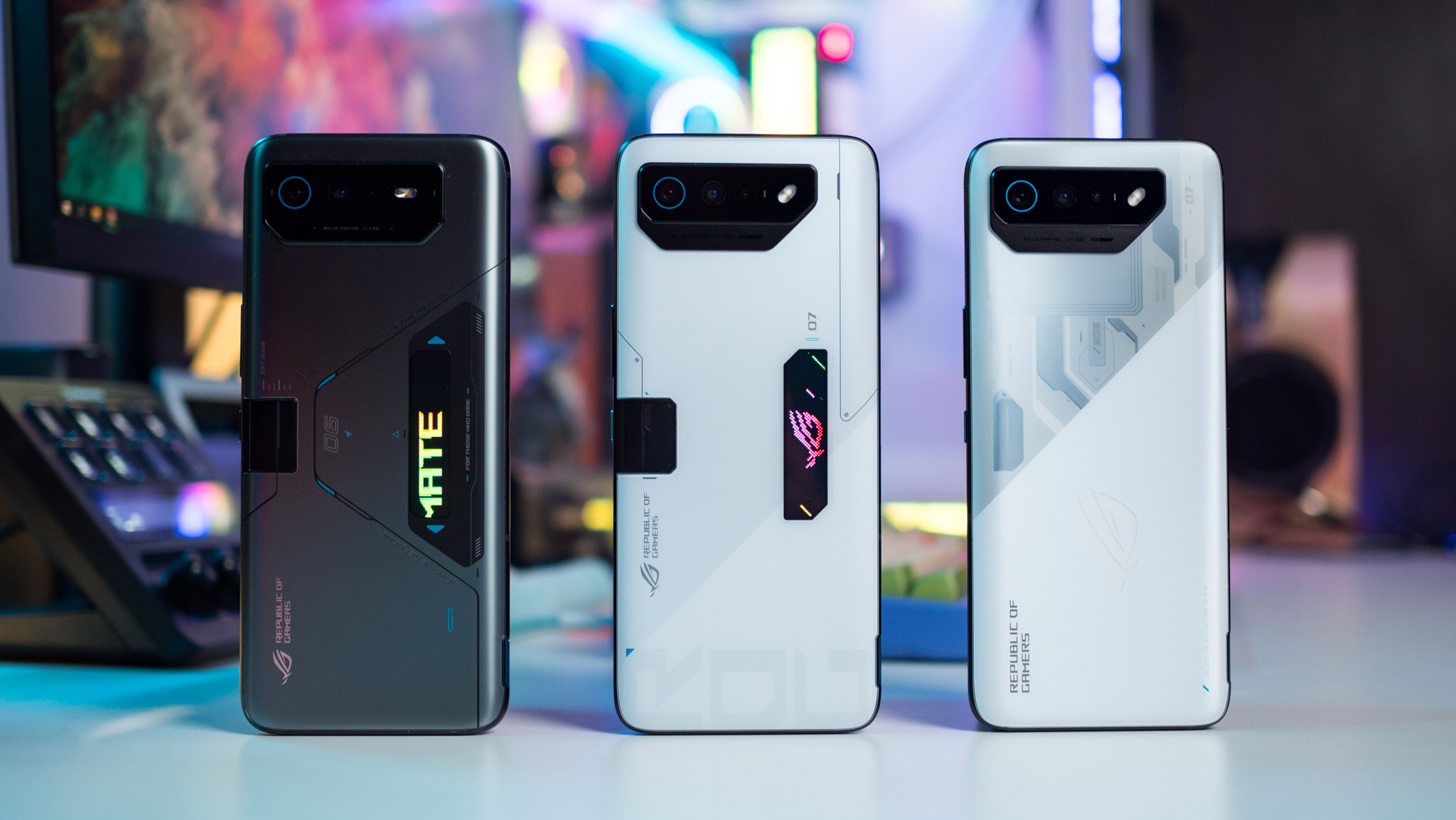
ASUS hasn't changed things too much on the design front, and that's a good thing. The ROG Phone 7 Ultimate has excellent in-hand feel, and the bold styling at the back is guaranteed to turn heads. You get the same jagged design for the camera housing that looks great, and it is a bit more prominent this time around.
Get the latest news from Android Central, your trusted companion in the world of Android
The design itself is a little more restrained, and the result is that the ROG Phone 7 Ultimate looks cleaner and a bit more modern than its predecessor. There's ROG branding at the bottom, and the ROG Vision panel at the back doesn't have a large border surrounding the screen, giving it a cleaner look.

ASUS is offering the ROG Phone 7 Ultimate in a single Storm White color variant, and the white colorway does a much better job accentuating the design. There's a two-tone finish at the back, and the matte texture ensures the device doesn't attract any smudges. Like previous years, ASUS did a fantastic job with weight distribution, and although the ROG Phone 7 Ultimate is one of the heaviest phones around — at 239g, it's 5g heavier than the Galaxy S23 Ultra — you don't notice that in daily use.
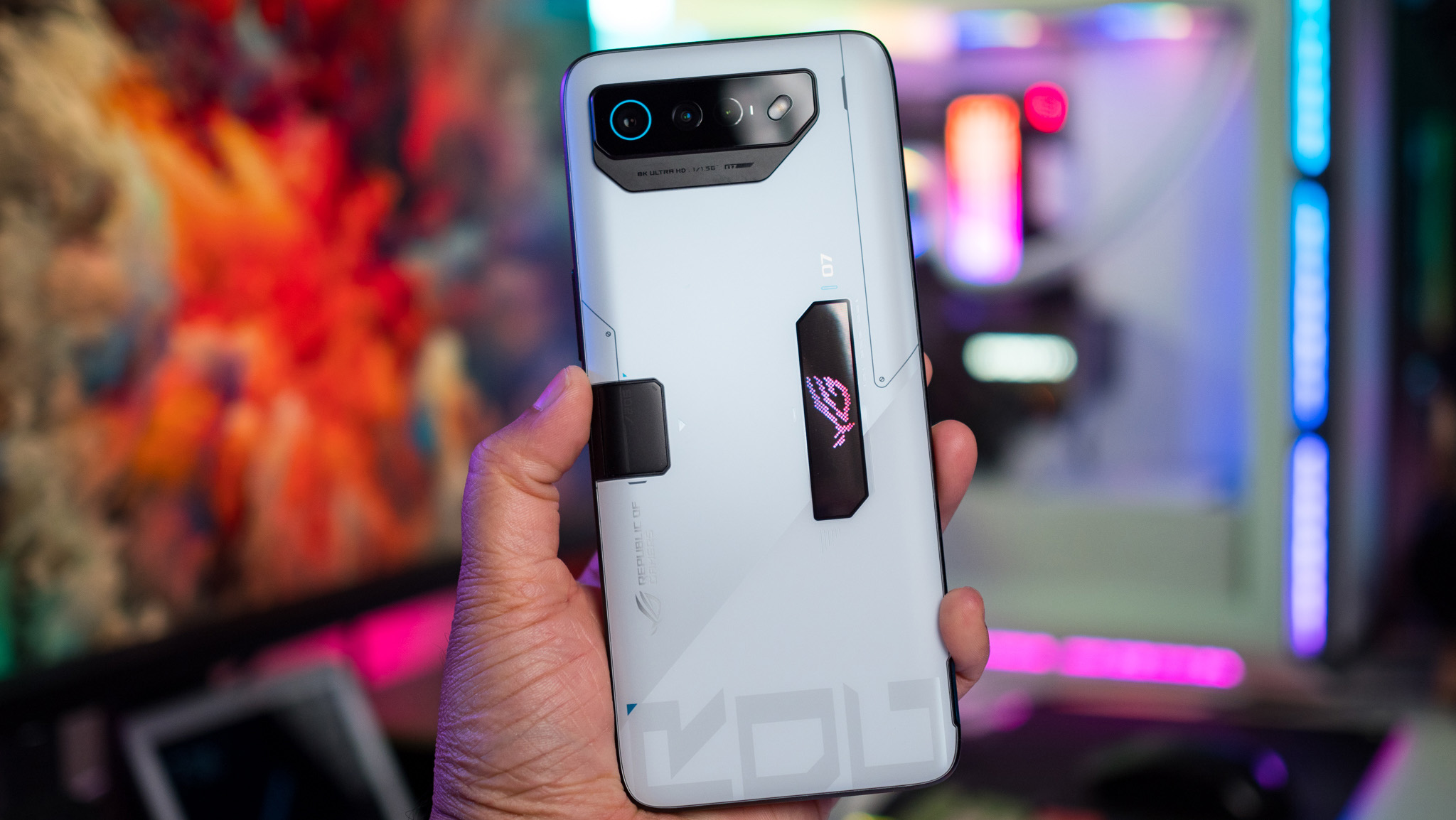
A key highlight at the back of the phone is the ROG Vision color PMOLED display, which is essentially a 2-inch screen at the back that shows off various static images or animations. It can also be used in various situations in receiving calls, launching games, or as a visual indicator when the phone is charging. There's much more configurability this time around, with ASUS adding 60 new animations to the library, and you have the ability to create your own effects.
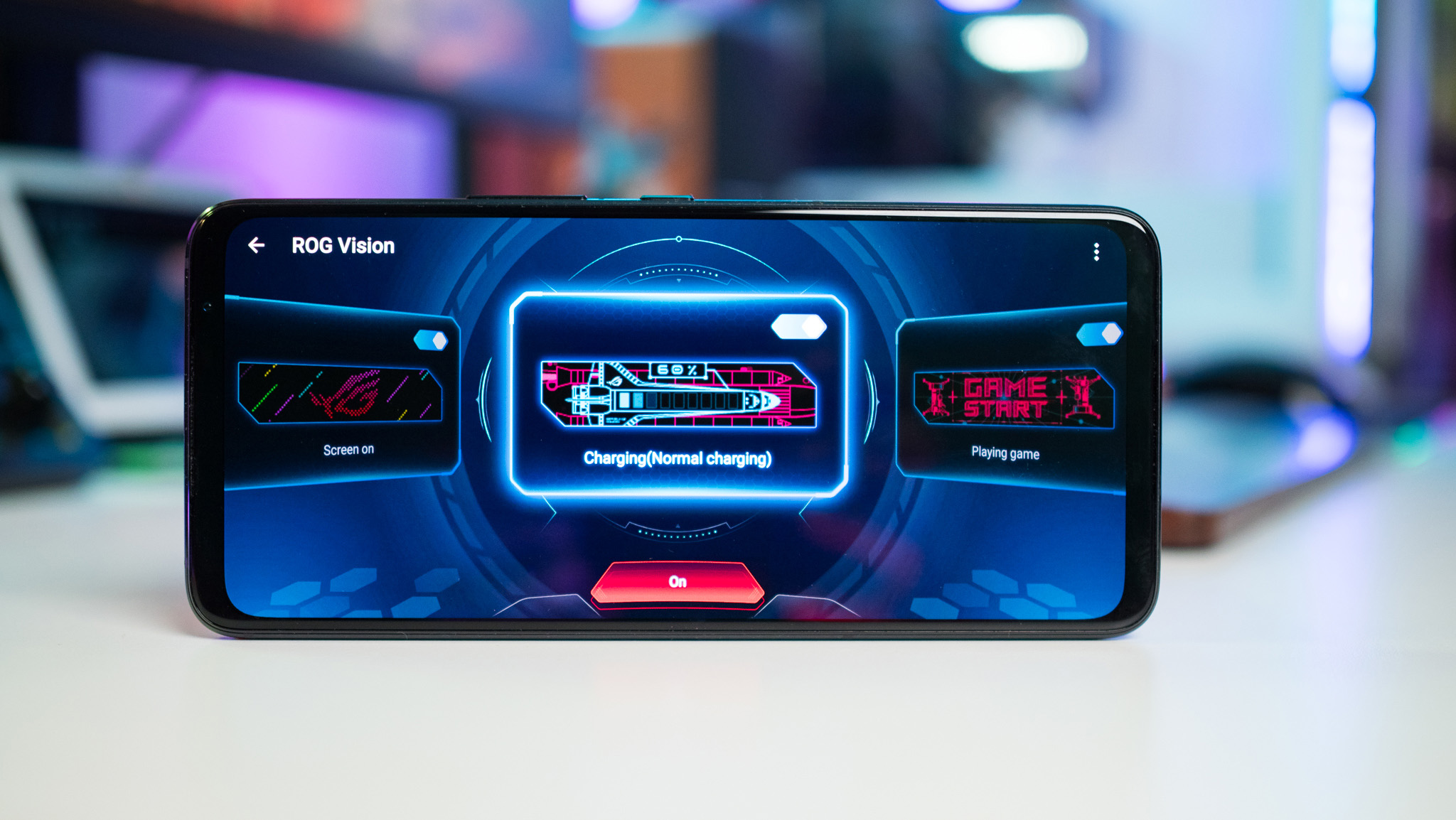
The ROG Vision is one of my favorite features on the ROG Phone 7 Ultimate, and it works just as well as previous years. In a similar vein, the AeroActive Portal that debuted on the ROG Phone 6D Ultimate last year is back, and it works in conjunction with the AeroActive Cooler 7 to deliver much better cooling to the device. The portal is basically a motorized slider that's made out of 50 parts, and there's a hinge that opens automatically once you connect the AeroActive Cooler, allowing the cooler to funnel airflow directly into the internal components.

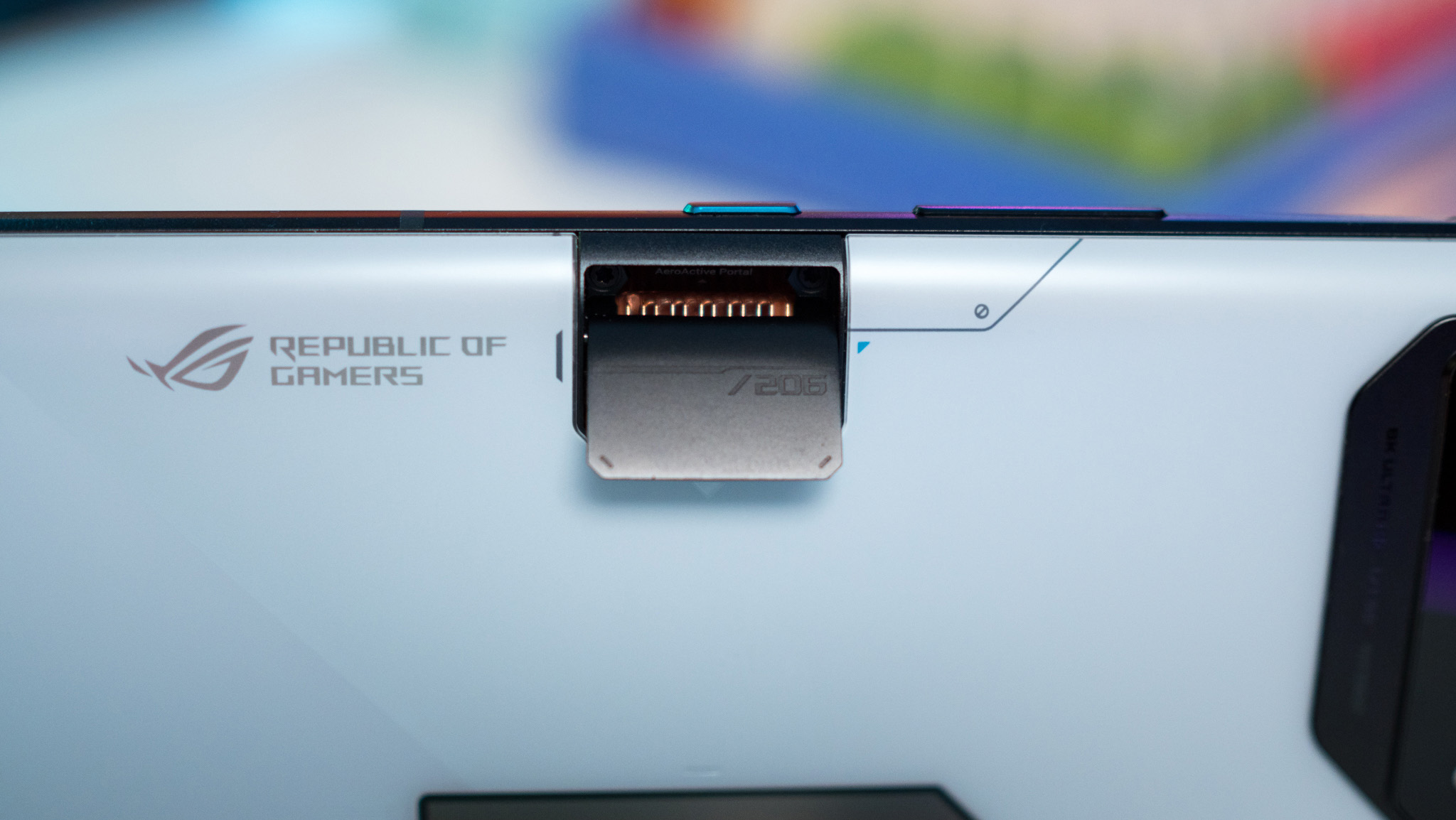
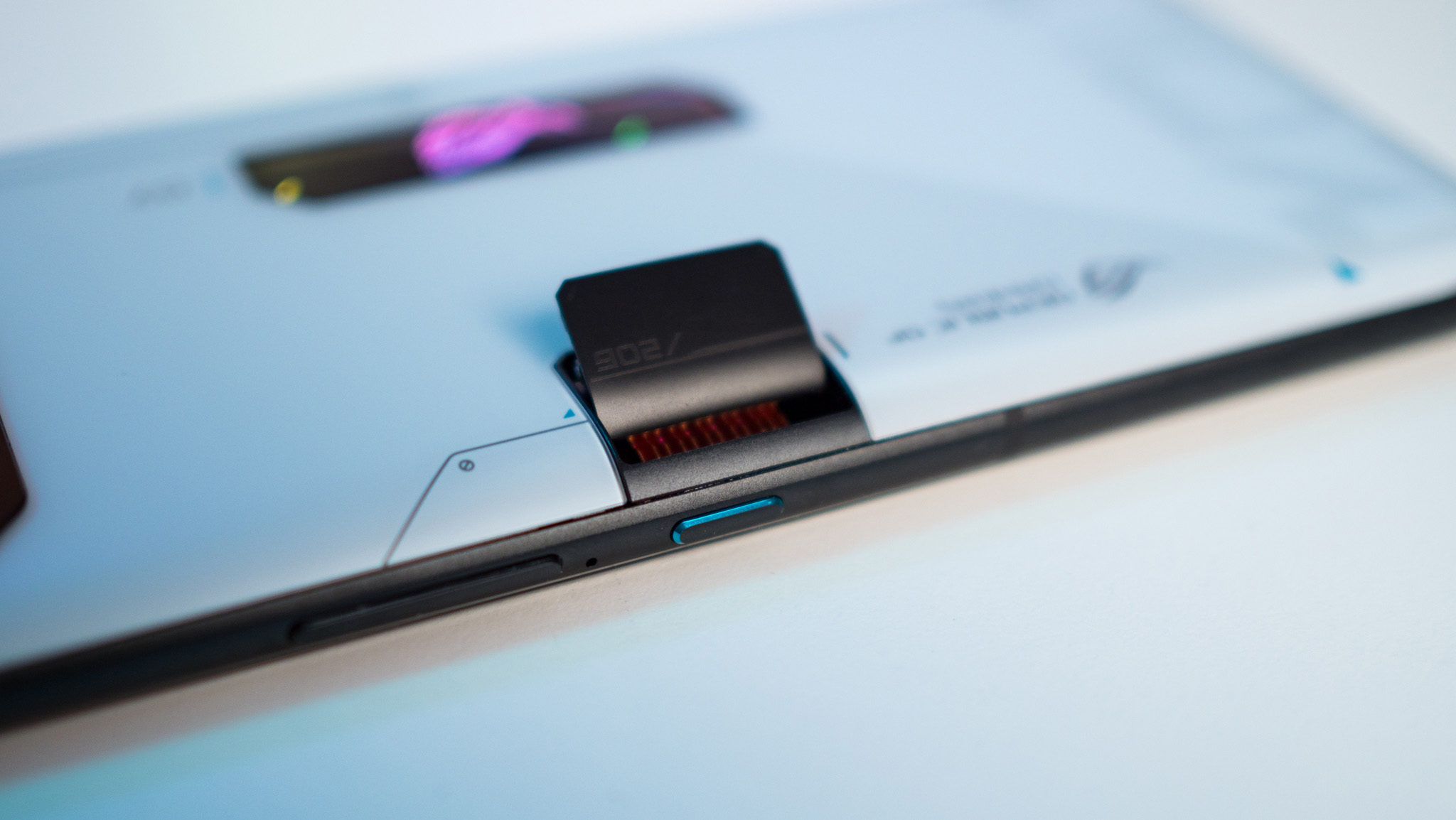
It is a unique feature that isn't available on any other gaming phone, and having used it extensively last year, I can attest to its performance during marathon gaming sessions. It makes a noticeable difference to thermal management, and allows the phone much better headroom in this area. The housing for the portal is made out of stainless steel, and ASUS says the hinge has been tested for 40,000 unlocks.

Build quality itself is among the best in the industry, and the phone features an aluminum chassis that's sandwiched between two panes of glass. You'll find Gorilla Glass 3 at the back and Victus at the front, and the back has symmetric curves where it meets the mid-frame, making it that much easier to hold and use the phone. You'll find the same blue accents around the main camera module, power button, and the SIM card slot, and that gives a little more flair to the design.
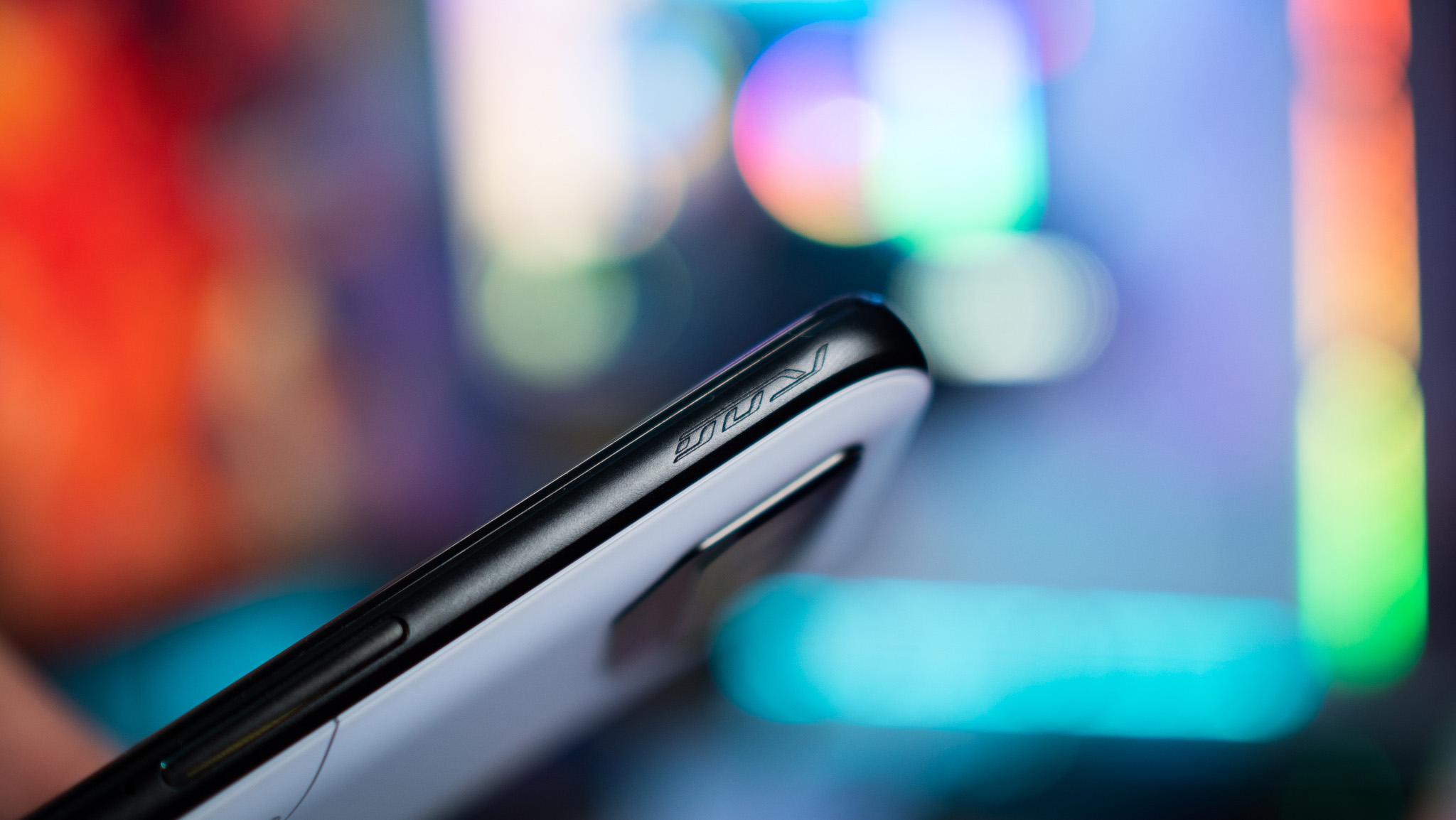
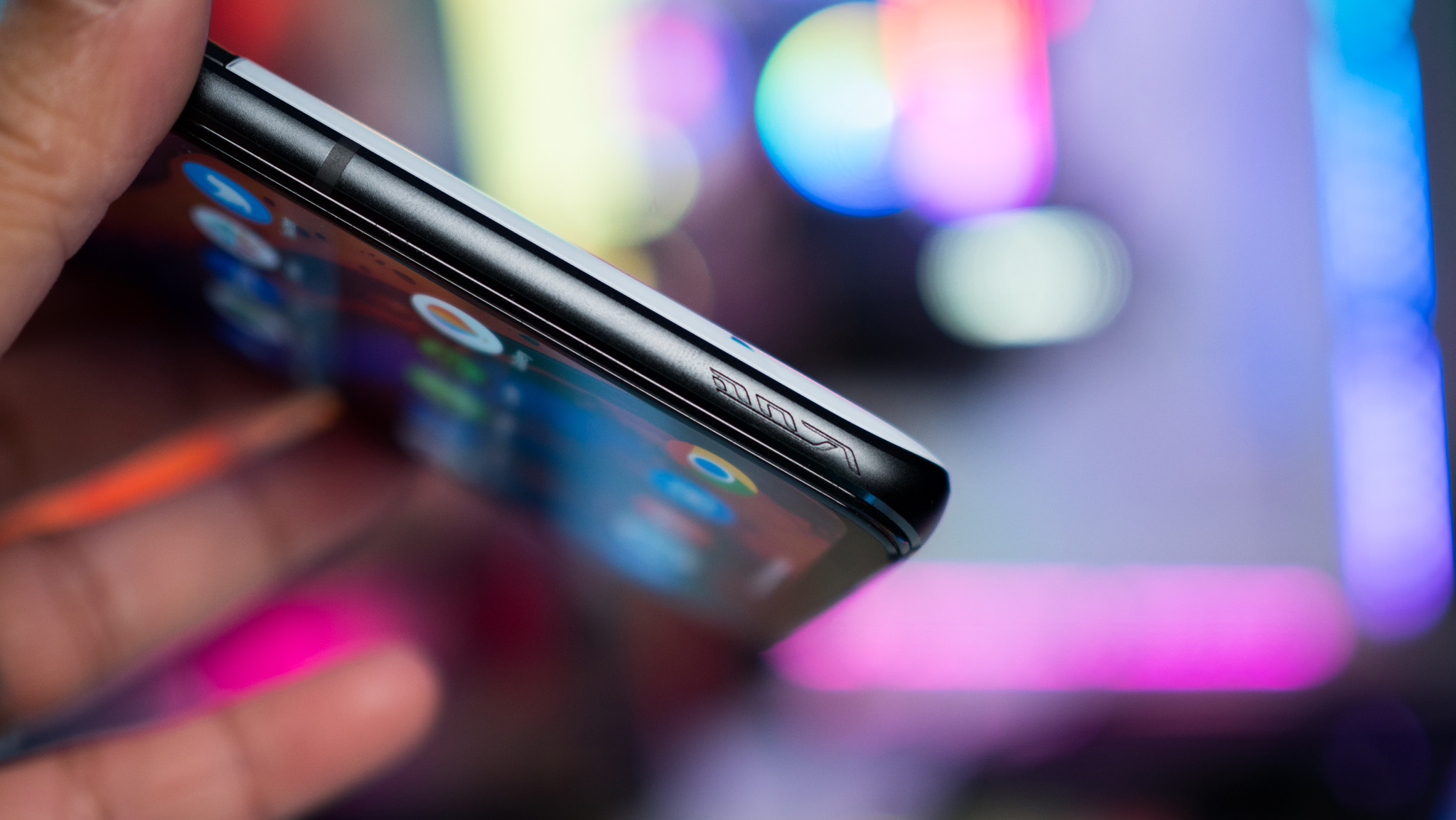
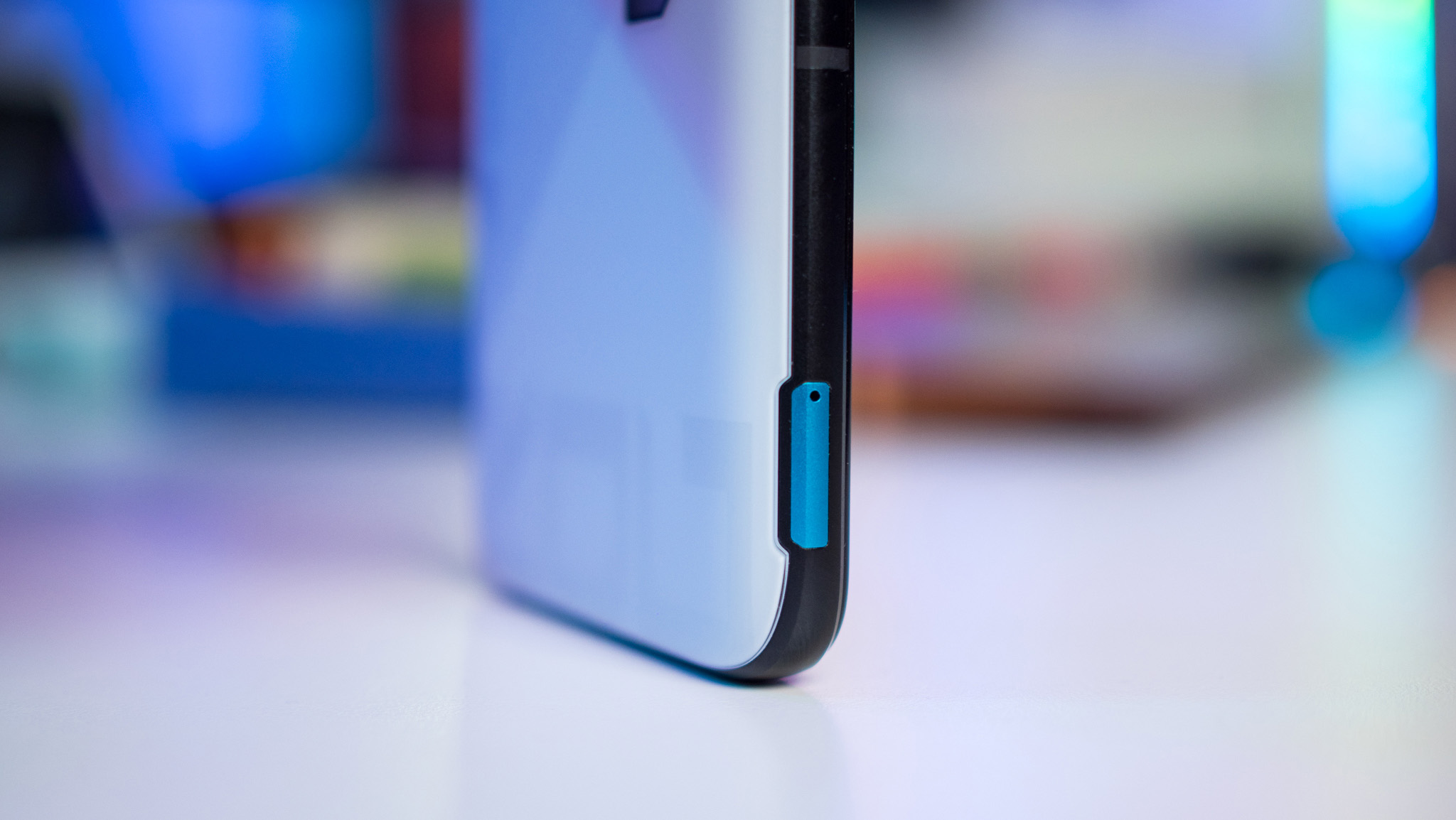
AirTriggers are back, and you'll find two ultrasonic buttons on either side on the right, and they offer extensive customization for in-game actions. The power button and volume rockers are on the right as well, and the former is located just below where your thumb rests. The USB-C port at the bottom is located to the left, and it doesn't come in the way if you're charging the device while gaming.
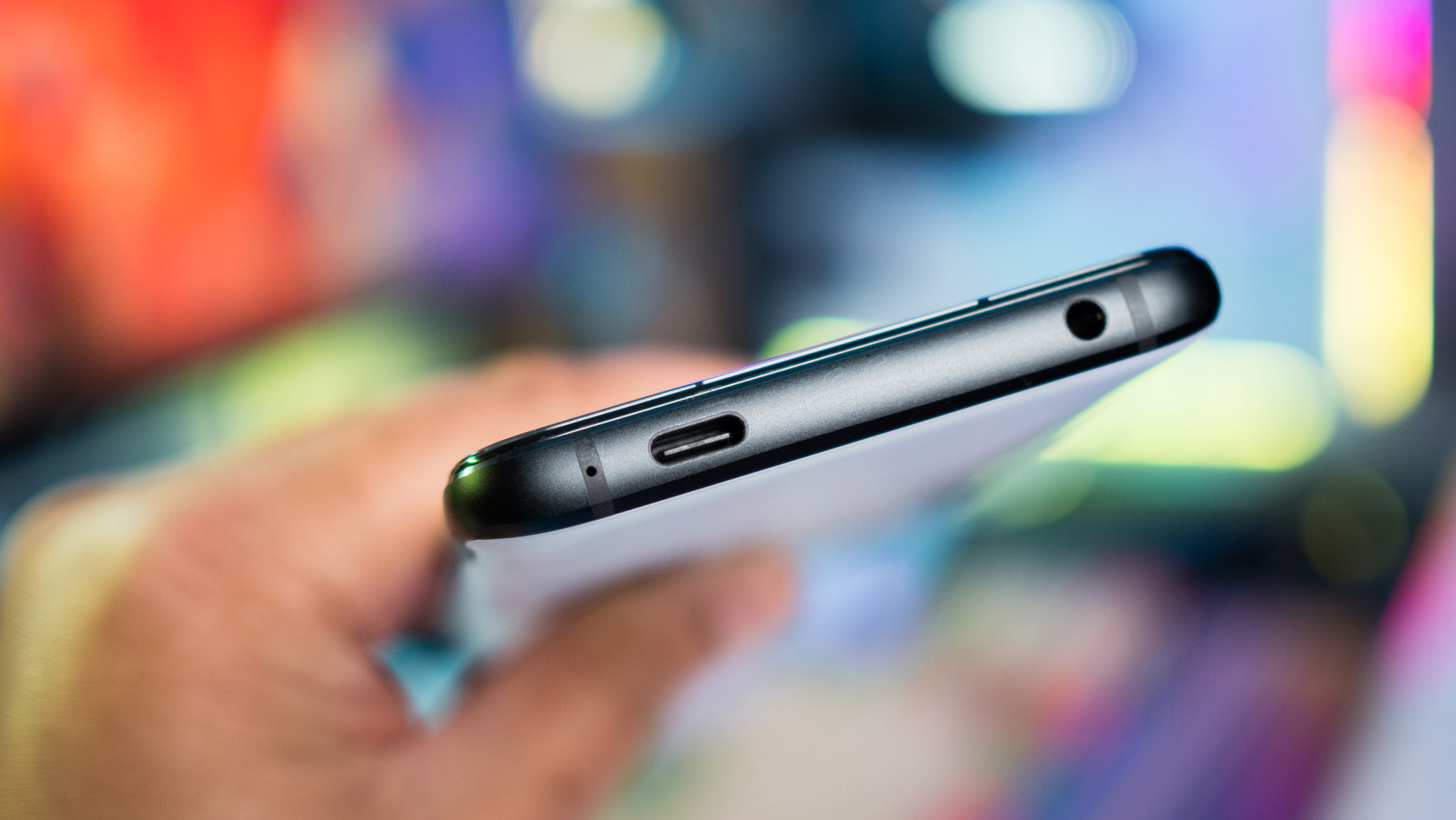
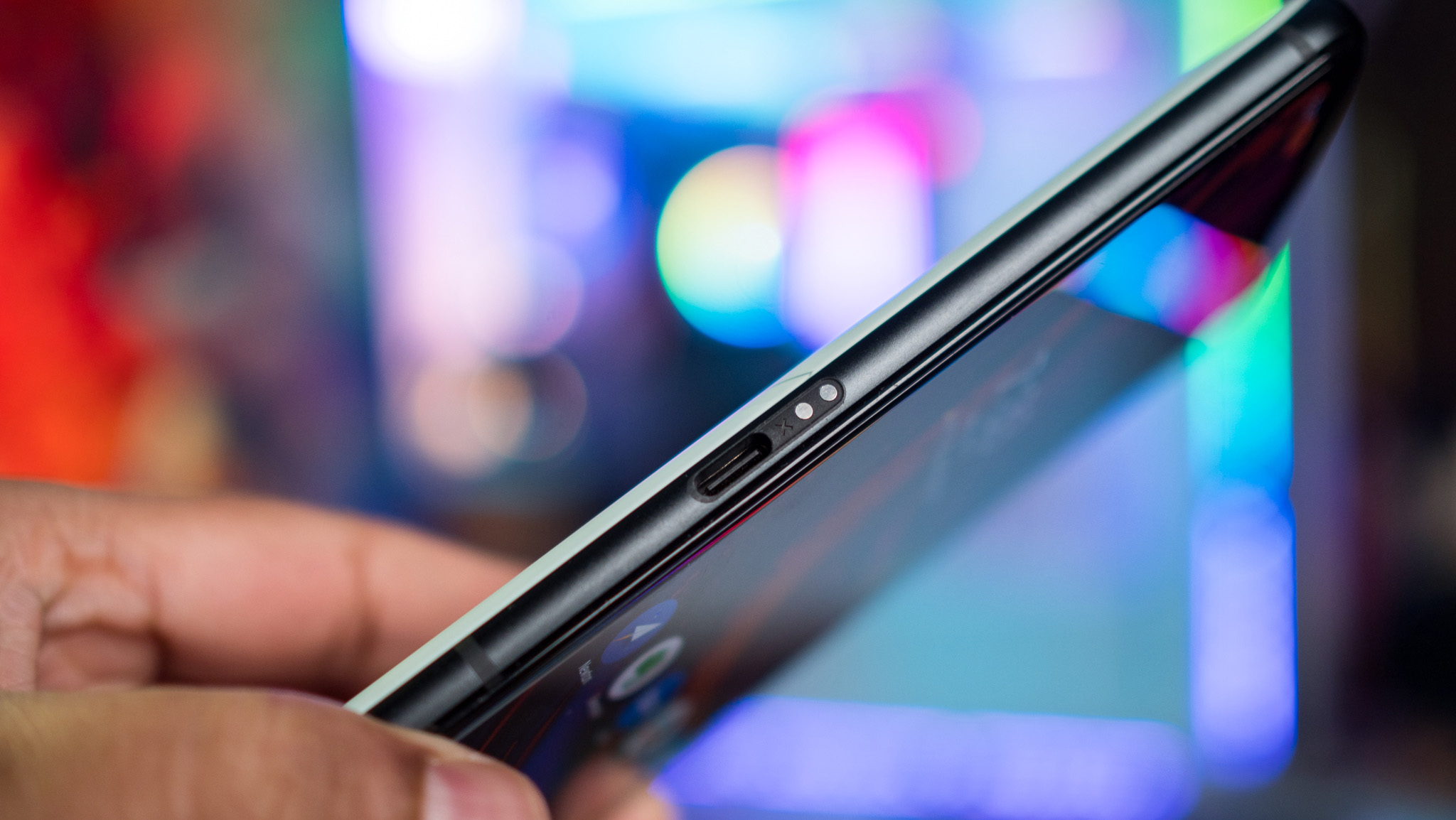
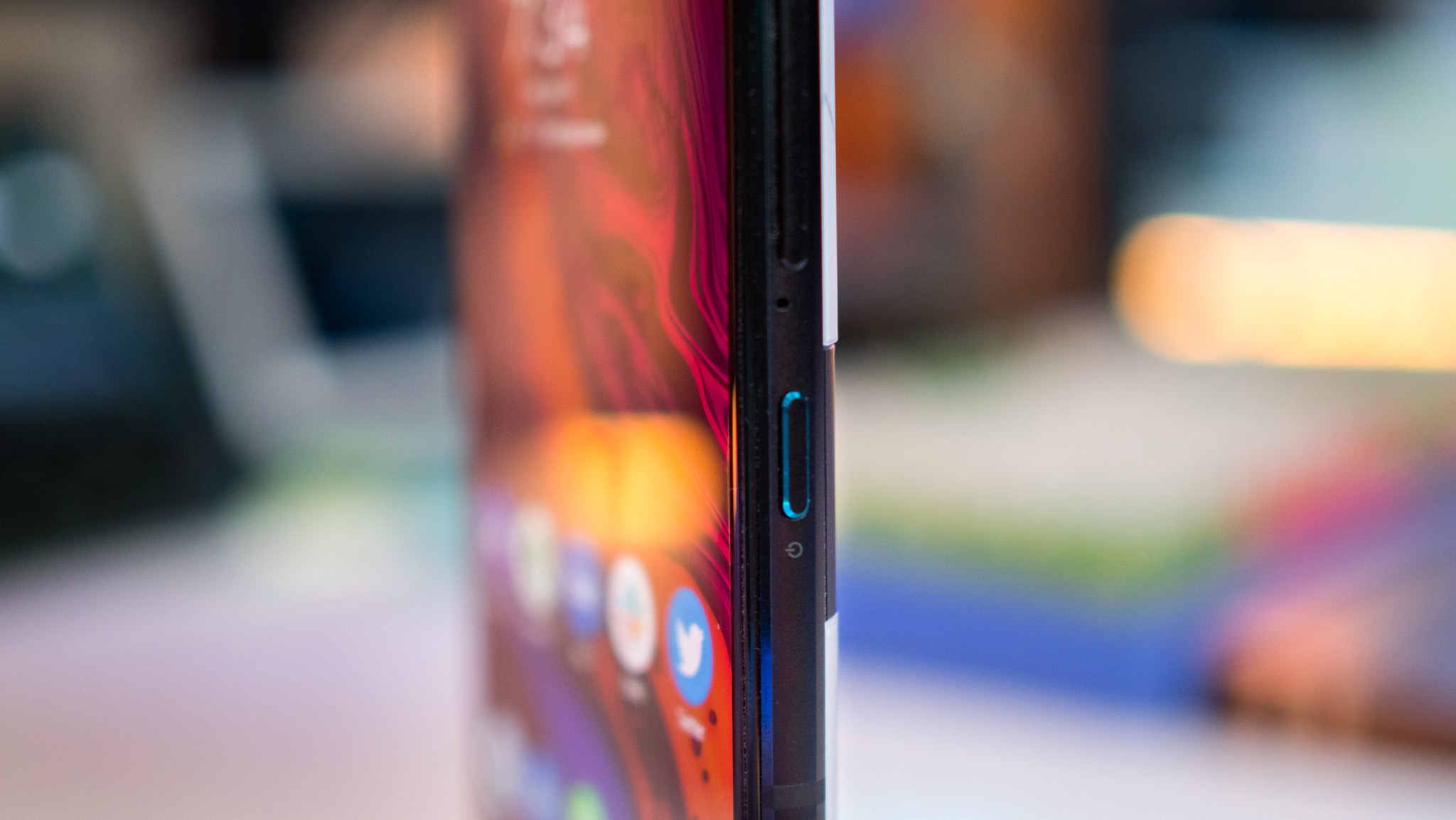
A feature that I particularly like this year is IP54 ingress protection. Sure, it isn't quite the same as the IP68 standard that you'll find on the best Android phones, but ASUS deserves credit for adding some level of dust and water resistance to the device. Finally, the phone retains the 3.5mm jack, a commendable feat in and of itself in 2023, and you'll find a side-mounted USB-C port that has been a mainstay on ROG Phones for a while now. A new addition this year is dual pogo pins that are used for connecting the AeroActive Cooler 7 to the device.
Overall, the ROG Phone 7 Ultimate has a fabulous design and is built like a tank. While it is an iterative update over its predecessor, it is still one of the best-looking gaming phones around, and the subtle tweaks for this generation give the device a little more character.
ASUS ROG Phone 7 Ultimate: Screen

ASUS hasn't changed the panel itself from last year, and the ROG Phone 7 Ultimate features a 6.78-inch Samsung AMOLED screen with 165Hz refresh, 720Hz polling, and a touch latency of just 23ms. While the screen itself is unchanged, the biggest change is brightness levels — the phone is now able to hit up to 1,000 nits in auto mode and 1,500 nits for HDR content, with both figures significantly higher than last year.


The screen is fantastic in daily use, and a big part of that is down to the fact that it isn't marred by a cutout. Sure, the bezels are larger than what you'll find on other high-end phones, but they're not intrusive, and ASUS somehow managed to tuck the front camera and an RGB notification LED in such a small area.
But what's more intriguing is that you get identical speakers at the front, and they sound phenomenal. The phone gets incredibly loud in regular use, and the sound is detailed and doesn't get distorted even when you crank up the volume.

I'll talk more about the AeroActive Cooler 7 further below, but a nifty addition this year is that it has a tiny subwoofer, adding another channel to the stereo sound and giving you a portable 2.1 configuration on the go. There's a noticeable difference to the sound when the cooler's subwoofer is enabled, and it is just one more thing that makes using the ROG Phone 7 Ultimate so much fun.
On that note, ASUS once again teamed up with Dirac for tweaking the audio on the ROG Phone 7 Ultimate, and the AudioWizard feature offers extensive customizability. There are four modes available — Dynamic, Music, Cinema, and Game — and there's also a 10-band EQ that lets you fine-tune the sound to your preferences.

As for color accuracy, ASUS did a brilliant job with color calibration out of the box, and like previous years, you get a lot of customizability in this area. You can tweak the color balance and switch between the five available modes, and there's an always-on option available. The screen is covered by a layer of Gorilla Glass Victus.
By default, ASUS uses an auto refresh feature to change the screen refresh rate based on the content playing on the screen, but you can manually set it to 60, 90, 120, 144, or 165Hz and it will stay locked to that setting. As this is ASUS, you get a lot of configurability, with Armoury Crate giving you the ability to customize the refresh rate for individual titles.
I set it to 165Hz as standard, and the phone is fluid like no other device I've used in 2023 — ASUS deserves a lot of credit for optimizing the hardware here, and using the ROG Phone 7 Ultimate is an absolute joy.
The phone has zero issues in titles that leverage high refresh rates, and the size of the screen and quality of onboard audio makes gaming on this device thoroughly enjoyable. Of course, that's to be considered given the target audience for the phone, and like previous years, ASUS did a magnificent overall job.
ASUS ROG Phone 7 Ultimate: Performance
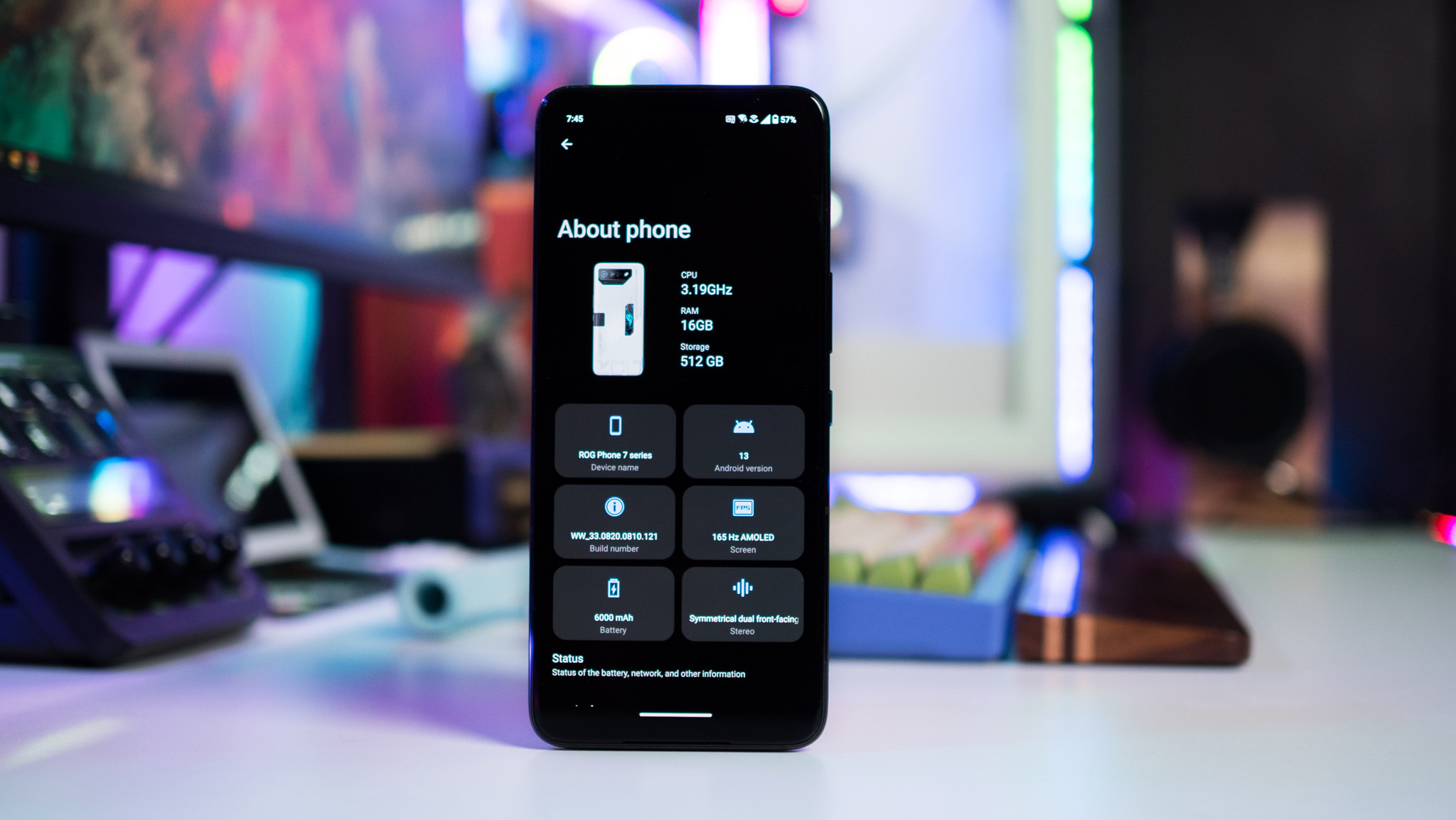
I always look forward to testing ASUS's gaming phones because they tend to deliver the best possible hardware of any Android phone, and that's no different with the ROG Phone 7 Ultimate. The phone is powered by Qualcomm's latest Snapdragon 8 Gen 2, and it features a Cortex X3 core at 3.2GHz, two Cortex A715 cores at 2.8GHz, two Cortex A710 cores at 2.8GHz, and three Cortex A510 cores at 2.0GHz along with the Adreno 740.
| Category | ASUS ROG Phone 7 Ultimate |
|---|---|
| OS | Zen UI based on Android 13 |
| Display | 6.78-inch 165Hz Samsung AMOLED, 2448 x 1080, 1500 nits, HDR10+, Gorilla Glass Victus |
| Second screen | 2-inch ROG Vision PMOLED at the back |
| Chipset | Qualcomm Snapdragon 8 Gen 2, 1 x 3.2GHz Cortex X3, 2 x 2.8GHz Cortex A715, 2 x 2.8GHz Cortex A710, 3 x 2.0GHz Cortex A510, Adreno 740, 4nm |
| RAM | 16GB LPDDR5X |
| Storage | 512GB UFS 4.0 |
| Rear camera 1 | 50MP Sony IMX766, f/1.9 1.0um pixels, PDAF, 8K at 24fps, 4K at 60fps |
| Rear camera 2 | 13MP f/2.2 wide-angle, 125-degree field of view |
| Rear camera 3 | 5MP macro |
| Front camera | 32MP f/2.5, fixed focus |
| Ingress protection | IP54 dust and water resistance |
| Gaming features | AirTriggers, X Mode, Armoury Crate |
| Security | In-screen optical fingerprint module, face unlock |
| Connectivity | Wi-Fi 7, Bluetooth 5.3, NFC, Sub-6 5G global bands |
| Audio | Stereo sound, 3.5mm jack, 24-bit/192kHz playback, AptX suite |
| Battery | 6000mAh, 65W USB PD 3.0 wired charging, bundled 65W fast charger |
| Dimensions | 173 x 77 x 10.3mm, 239g |
| Colors | Storm White |
The Snapdragon 8 Gen 2 is fabbed on a 4nm node, and the big deal with this generation is its ability to deliver sustained gaming performance without throttling. That's been the biggest differentiator while testing the likes of the Galaxy S23 Ultra, Xiaomi 13 Pro, iQOO 11, Find X6 Pro, and other Android phones powered by Qualcomm's latest silicon, so it's no wonder that the ROG Phone 7 Ultimate benefits from the same advancements.
This year, ASUS is offering a single version of the device with 16GB of LPDDR5X RAM and 512GB of UFS 4.0 storage. As you'd imagine, the ROG Phone 7 Ultimate is outstanding in daily use, and it is one of the fastest — if not the fastest — phones available today. The interface is fluid like no other device I've used, and it handles any game you throw at it without breaking a sweat.
| Category | ROG Phone 6D Ultimate | ROG Phone 7 Ultimate | Galaxy S23 Ultra |
|---|---|---|---|
| CrossMark (Overall) | 1116 | 1224 | 1295 |
| Productivity | 1181 | 1266 | 1185 |
| Creativity | 1001 | 1161 | 1411 |
| Responsiveness | 1292 | 1295 | 1310 |
| Geekbench 6 (single-core) | 1413 | 2008 | 1931 |
| Geekbench 6 (multi-core) | 3889 | 5607 | 4971 |
| 3DMark Wild Life Extreme (score) | 2641 | 3752 | 3488 |
| 3DMark Wild Life Extreme (score) | 15.8 | 22.5 | 20.9 |
That's evident in the synthetic scores as well. Things are interesting this year as Samsung is using a customized version of the Snapdragon 8 Gen 2 for its Galaxy S23 series that sees the Cortex X3 core go up to 3.36GHz, but ASUS still comes out ahead in all synthetic workloads thanks to its class-leading thermal management.
In fact, this is the fastest phone I tested to date, and the Geekbench 6 scores are higher than any other device; the multi-core score at 5607 is 12% faster than what the S23 Ultra, and that's a huge deal.
In a similar vein, the device aces 3DMark's Wild Life Extreme test, delivering the best scores of any phone today. In fact, ASUS manages to outmatch the iPhone 14 Pro in this area. And as you can make out, there are sizeable gains across the board over last year's Dimensity 9000-powered ROG Phone 6D Ultimate, showcasing just what Qualcomm has achieved this year with the 8 Gen 2.
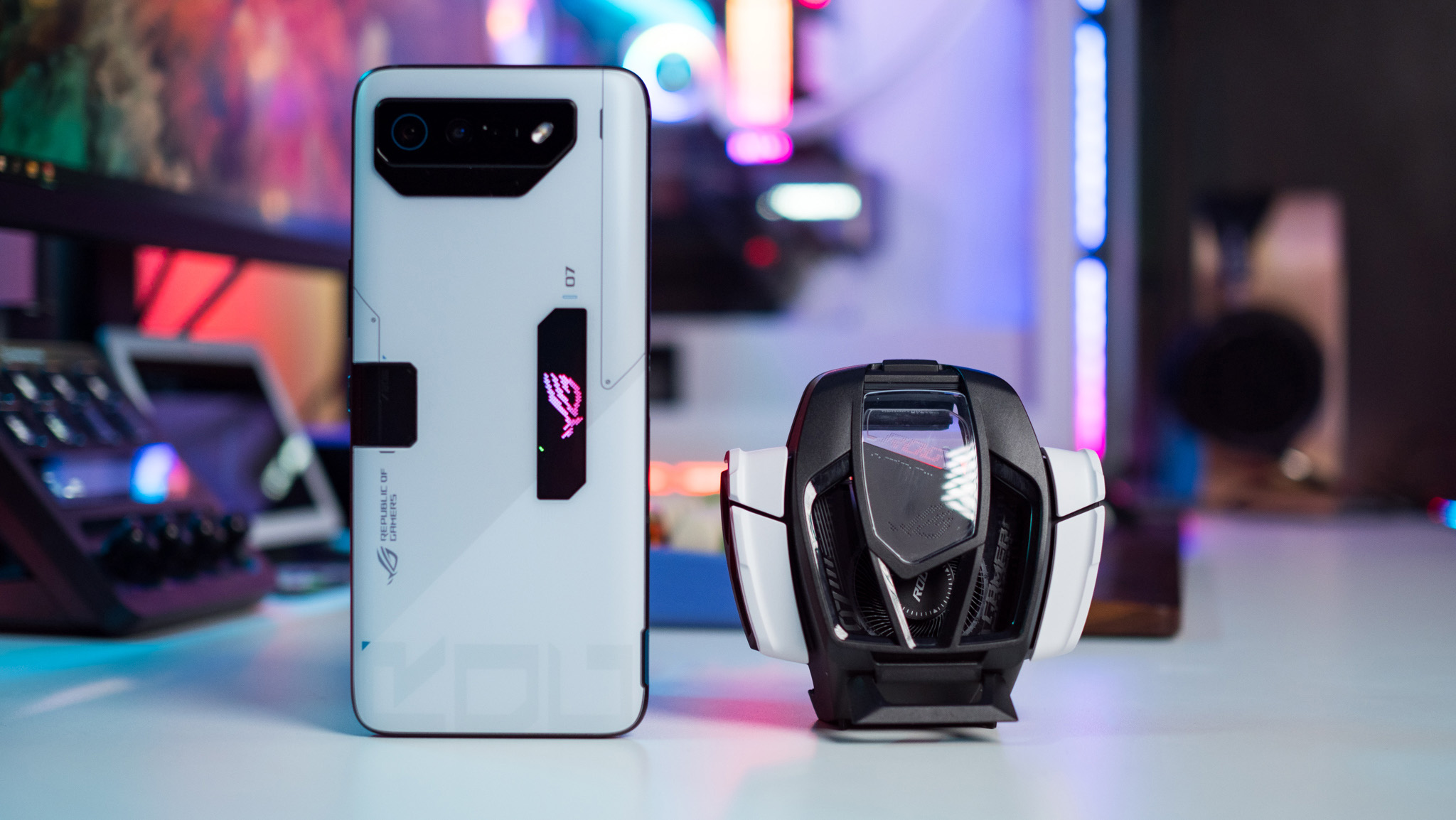
ASUS overhauled the cooling system on the ROG Phone 7 Ultimate, utilizing a new design for the vapor chambers and increasing their size, and the result is that the phone delivers incredible sustained performance figures. More than anything else, what stands out in this area is the consistency; even during extended gaming sessions, the ROG Phone 7 Ultimate continues to offer the same level of performance.
You still get extensive tuning options via Armoury Crate, with the ability to customize performance modes and tweak settings. X Mode is turned on by default when launching a game, and it turns up the hardware to the max and ensures the device doesn't throttle. There's thread balancing with this generation, and you can manually assign what cores are used for games.
AirTriggers are useful not just for gaming, but also in general use. With the ability to customize actions for short and long presses, you can launch the camera, toggle the flashlight, or set up a custom event with the feature, and it is versatile. In a similar vein, the vibration motor is excellent, and it offers granular feedback in daily use.
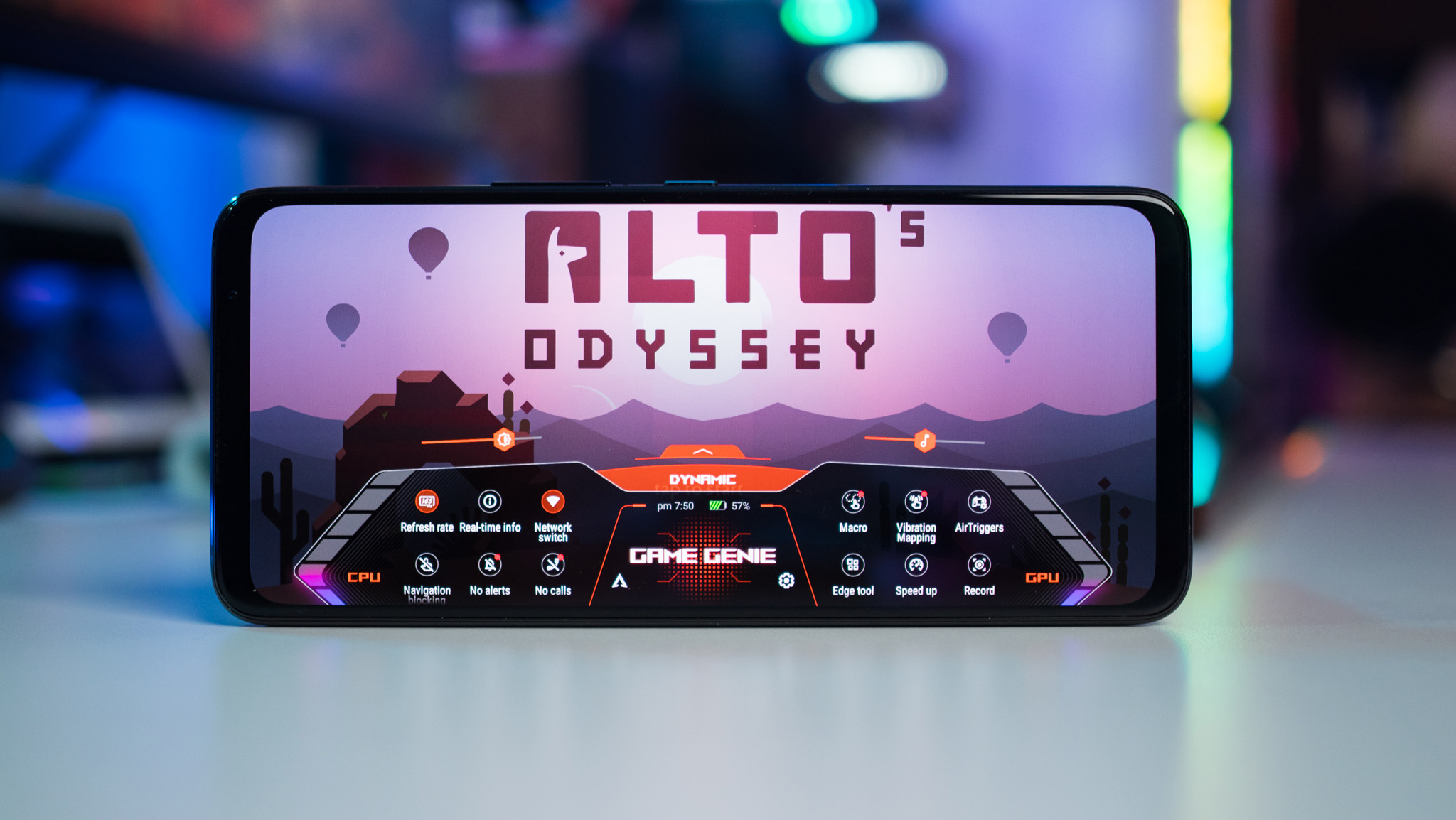
ASUS's Game Genie is one of the best around, offering exhaustive customizability for each game on the device. Like previous years, there's absolutely nothing missing on the connectivity front, with ASUS offering Wi-Fi 6e out of the box and an update to enable the Wi-Fi 7 modem later in the year.
There's Sub-6 5G connectivity with global bands, Bluetooth 5.2, and just about every high-res audio codec available, including the full AptX suite. The 3.5mm jack is paired with a decent onboard DAC that hits 24-bit/192kHz playback, and it works incredibly well with IEMs.
Other features include NFC, dual-band GPS, Glonass, Galileo, Beidu, and NavIC. The side-mounted USB-C port is based on the USB 3.1 Gen 2 standard and delivers a 4K signal over 60Hz, and the bottom USB-C port is based on USB 2.0. You get a decent set of accessories in the box, including the AeroActive Cooler 7 and a carrying case for the cooler, a case for the phone that works with the cooler, and a 65W charger with a USB-C to USB-C cable.
ASUS ROG Phone 7 Ultimate: Accessories
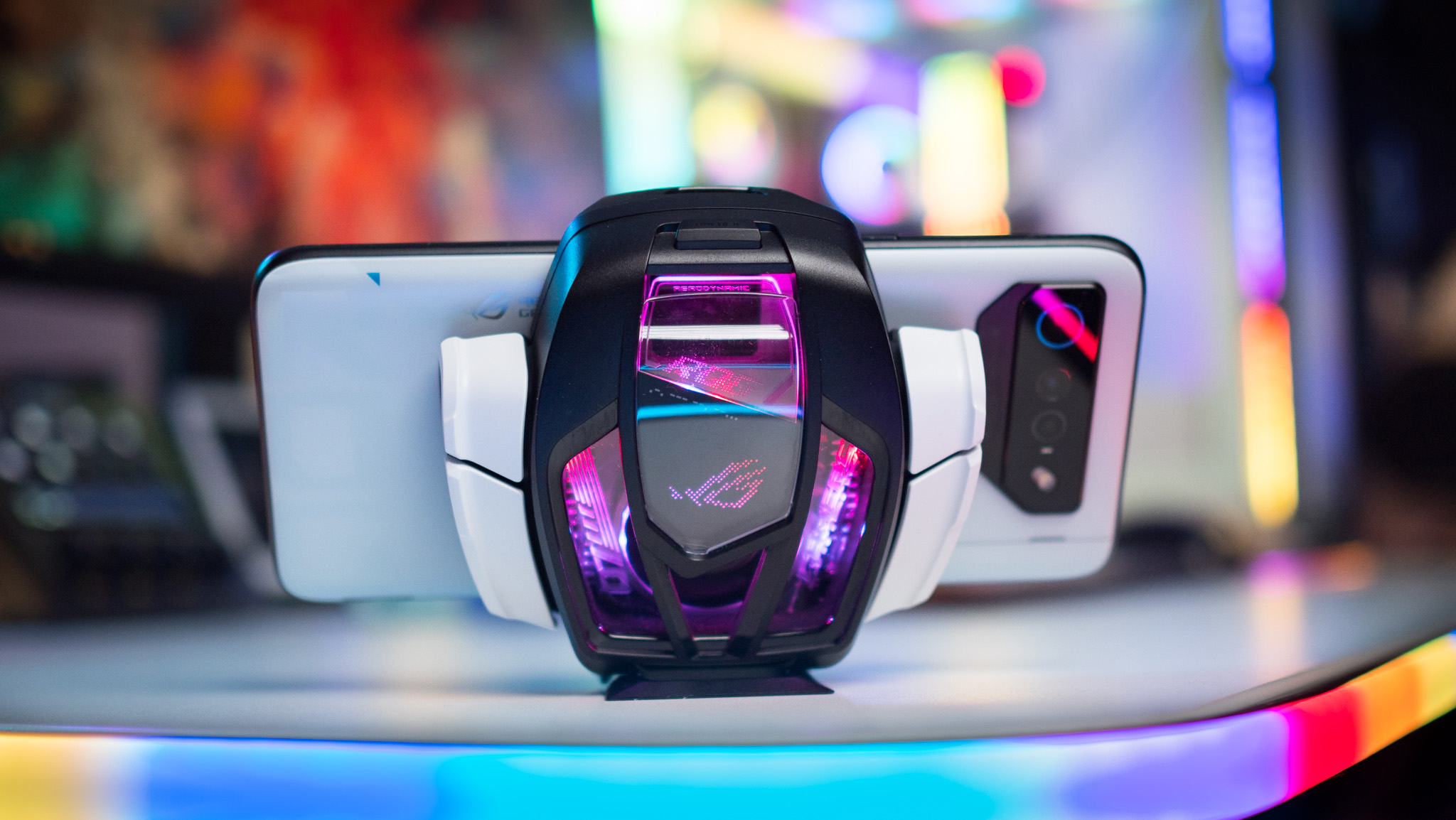
ASUS isn't offering as many accessories as previous generations, and is making a few changes to its ecosystem. If you've got an older ROG Phone, you can use some accessories with the ROG Phone 7 Ultimate, like the Kunai 3 Gamepad, but it doesn't have a snug fit. You can also use last year's AeroActive Cooler 6 with the latest phones, but the new AeroActive Cooler 7 uses pogo connectors and isn't compatible with earlier versions of ROG Phones.
Now, the AeroActive Cooler 7 itself underwent a major overhaul this year, and is considerably larger than its predecessor. It has the same aggressive styling with RGB lighting and the fan visible at the bottom, and a feature that I like is the inclusion of a 3.5mm jack. There's also a USB-C port — giving you the ability to use the side-mounted port with the cooler connected — and while it connects via USB-C, there are two pogo connectors as well this time around.
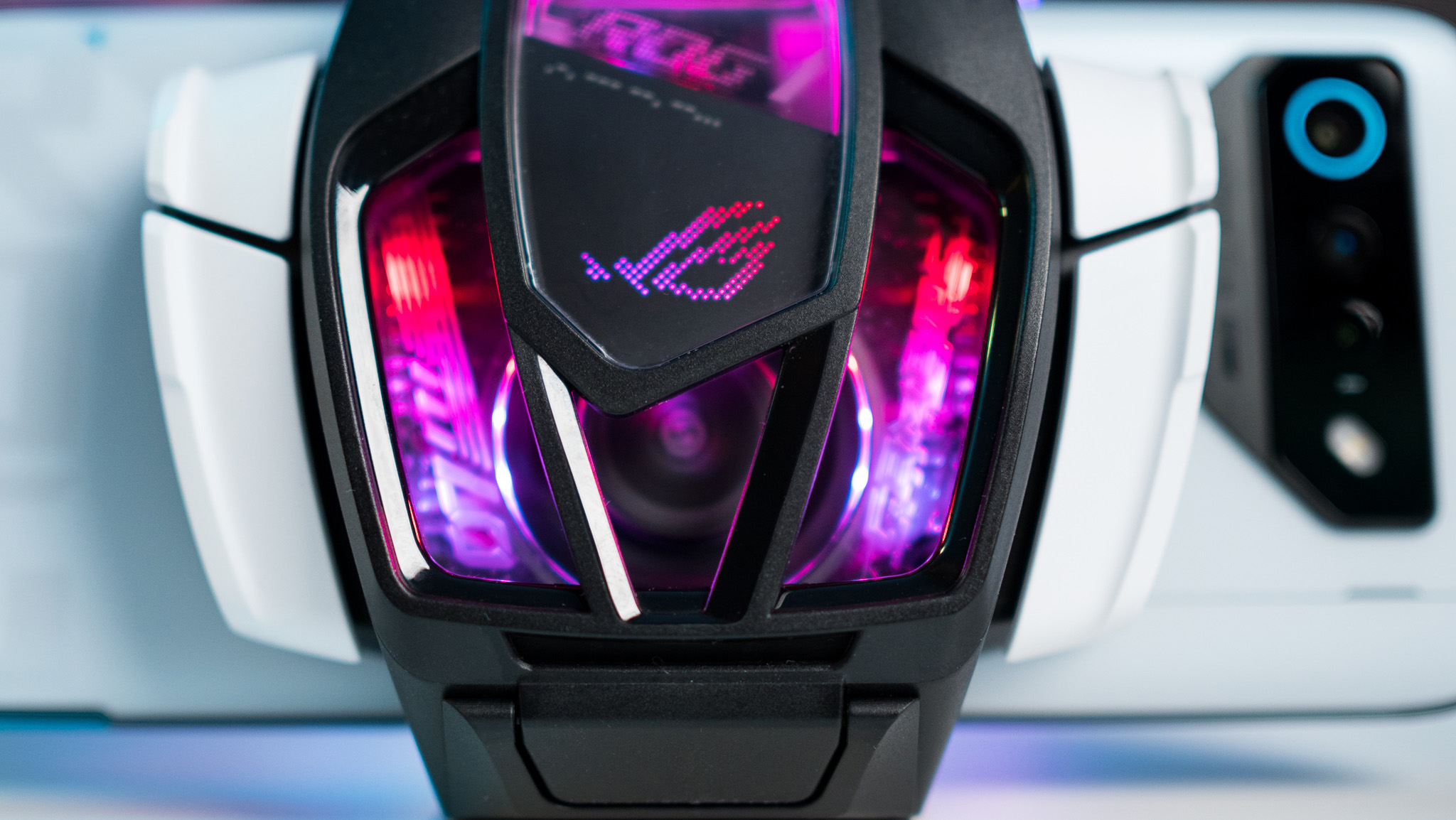
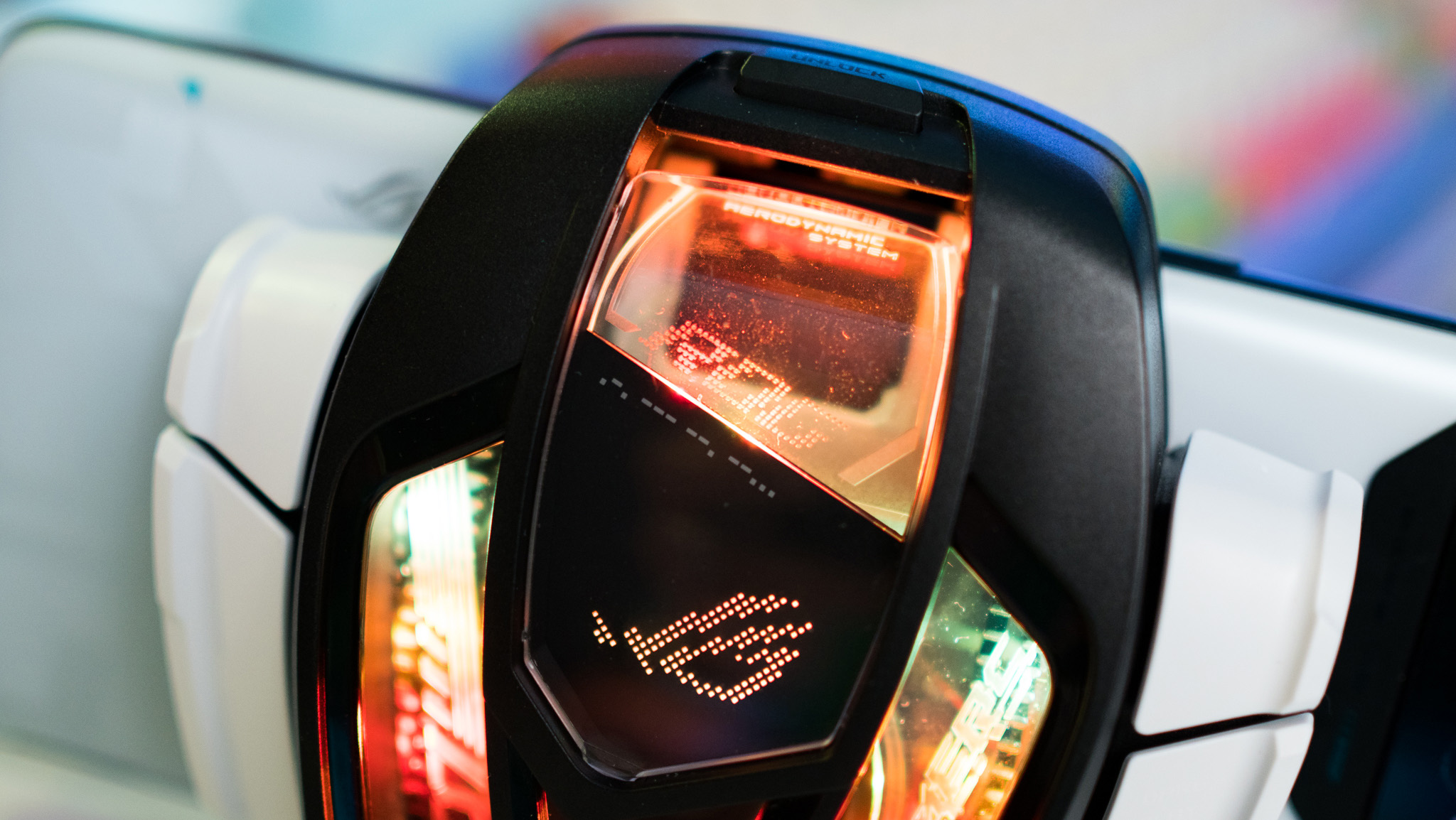
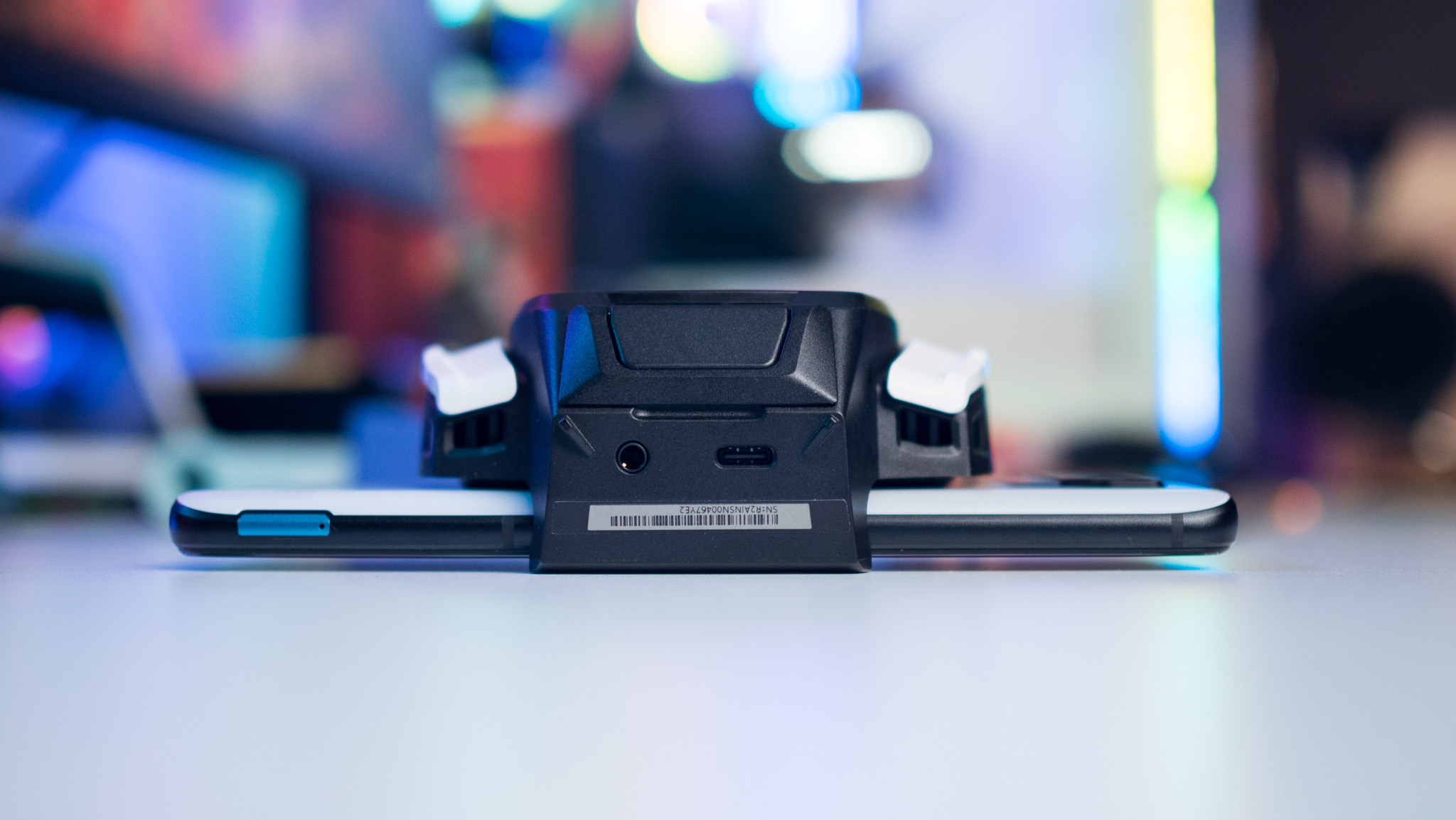

A big change this year is the addition of a subwoofer, and it makes a huge difference while gaming. The cooler is also easier to attach and detach thanks to a new spring-loaded system. Another new addition is an air duct that directs air to the front, blowing cool air over the screen. There's also an integrated kickstand built into the base, and you'll find four buttons on the cooler; like the phone itself, these are highly configurable.
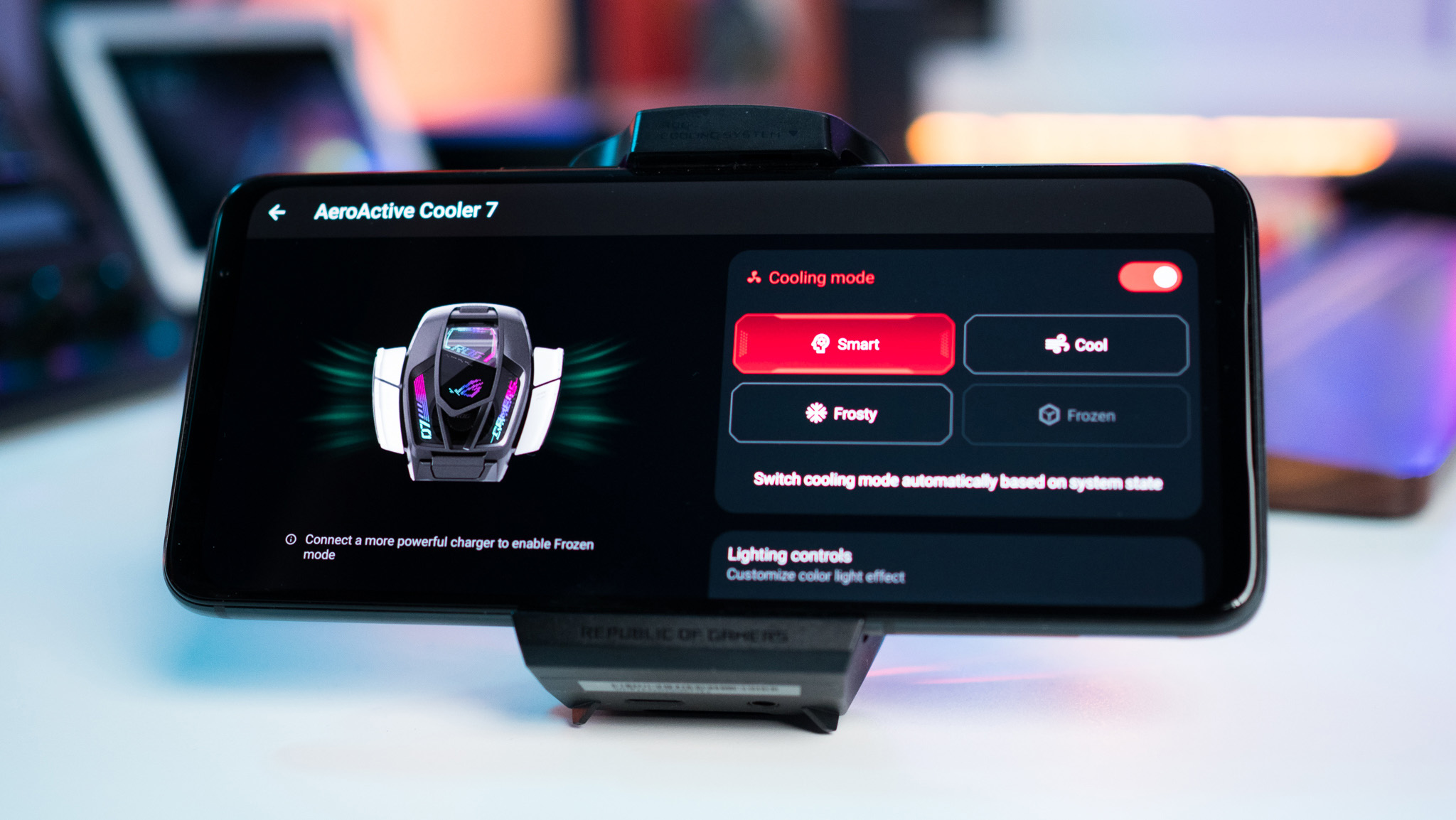
Like last year, there are four modes available for the cooler — Smart, Cool, Frosty, and Frozen — and usually, the Smart mode does a great job deciding how much airflow is needed to cool the internals based on real-time thermals. The Frozen mode delivers the best cooling potential, and unlike the other three modes, it needs external power to work. This comes in handy during extended gaming sessions, but most of the time, I just left the cooler in Smart mode and didn't see any issues.
ASUS ROG Phone 7 Ultimate: Battery life
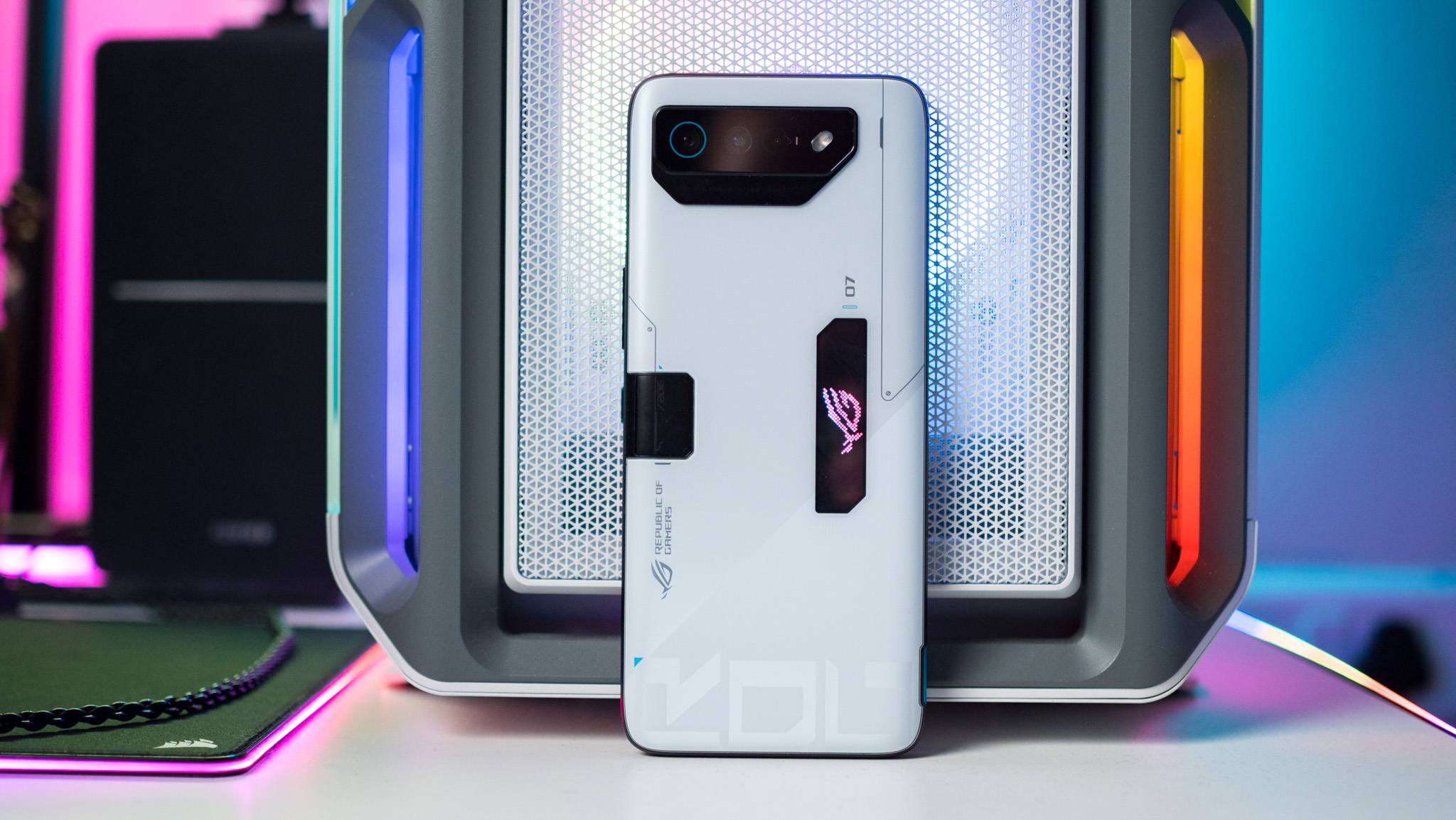
Thanks to a 6000mAh battery, the ROG Phone 7 Ultimate delivers outstanding battery life. The phone lasts well over a day with heavy use, and it can easily deliver two days between charges with medium use. That's down to the efficiency gains of the Snapdragon 8 Gen 2, and while all 2023 phones have benefitted to a degree in this regard, the larger battery here makes ASUS's offering stand out considerably.
Like last year, you'll find two 3000mAh cells that sit on either side of the Qualcomm hardware, and the charging tech is unchanged at 65W. It still uses USB PD 3.0, and the bundled charger can be used for charging other accessories that work over the PD 3.0 standard. It takes just under an hour to fully charge the battery, but you can get to the halfway point in just over 20 minutes.
ASUS continues to offer battery-focused features that aim to extend the longevity of the battery, and these include things like charging limit that lets you limit the charging to 90 or 80%. There's also a Steady charging feature that lowers the wattage while charging the device, ideal if you leave the phone plugged in overnight.
The only feature missing here is wireless charging, but other than that, ASUS did all the right things.
ASUS ROG Phone 7 Ultimate: Cameras
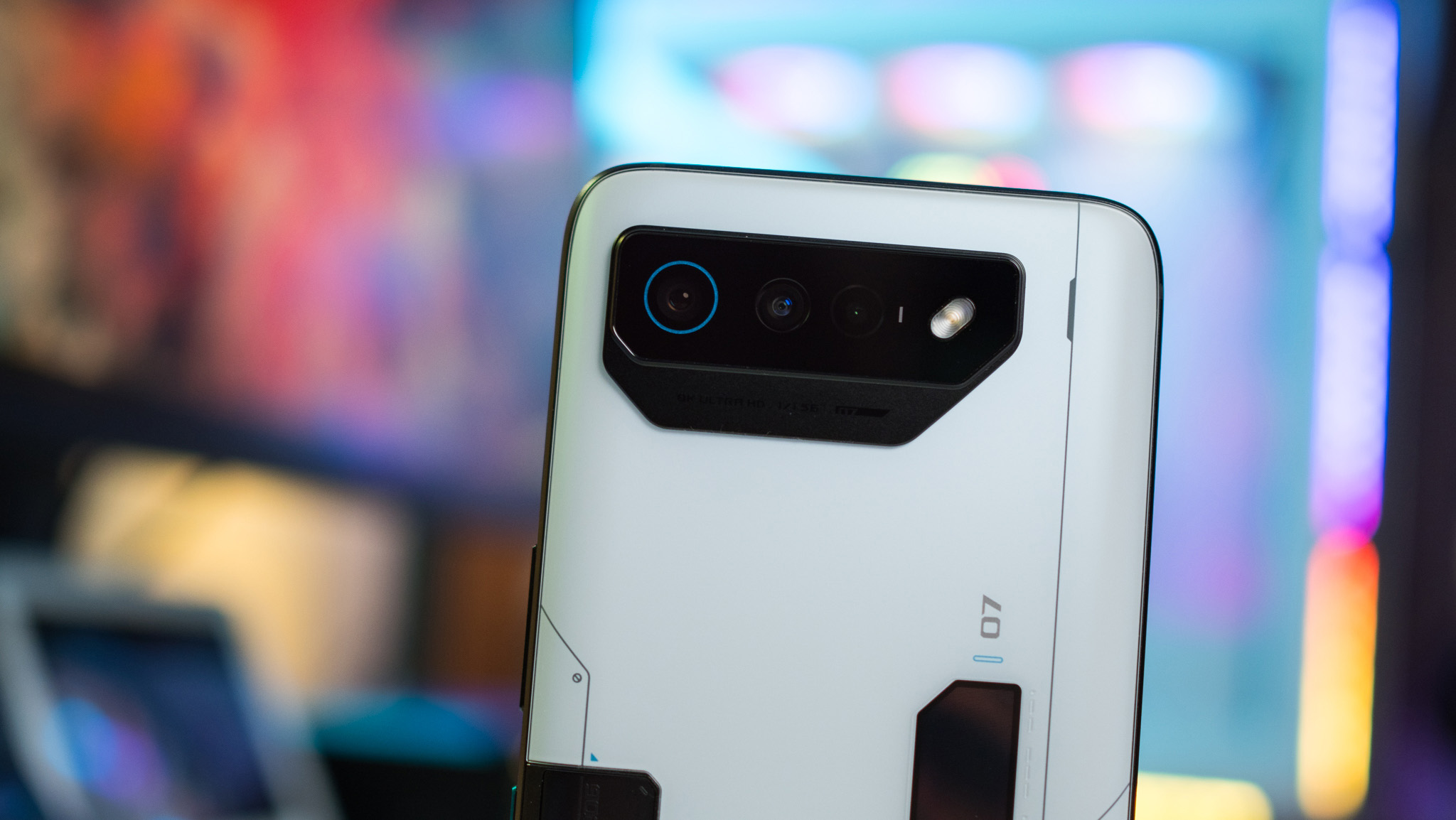
Cameras aren't a huge priority for ASUS, and you'll find the same 50MP Sony IMX766 primary camera as last year, along with a 13MP wide-angle lens with 125-degree field of view and a 5MP macro. There's a 32MP camera at the front that uses four-to-one binning to deliver 8MP shots.
The camera interface hasn't changed, and should be familiar if you've used an ASUS device in the past. While the hardware itself hasn't changed, ASUS made a lot of tweaks to the camera tuning to produce better shots in just about any situation. The light trail mode that debuted last year has been overhauled, and does a decent job for things like traffic trails. There's also a Pro mode available, and it now works with videos as well as photos.
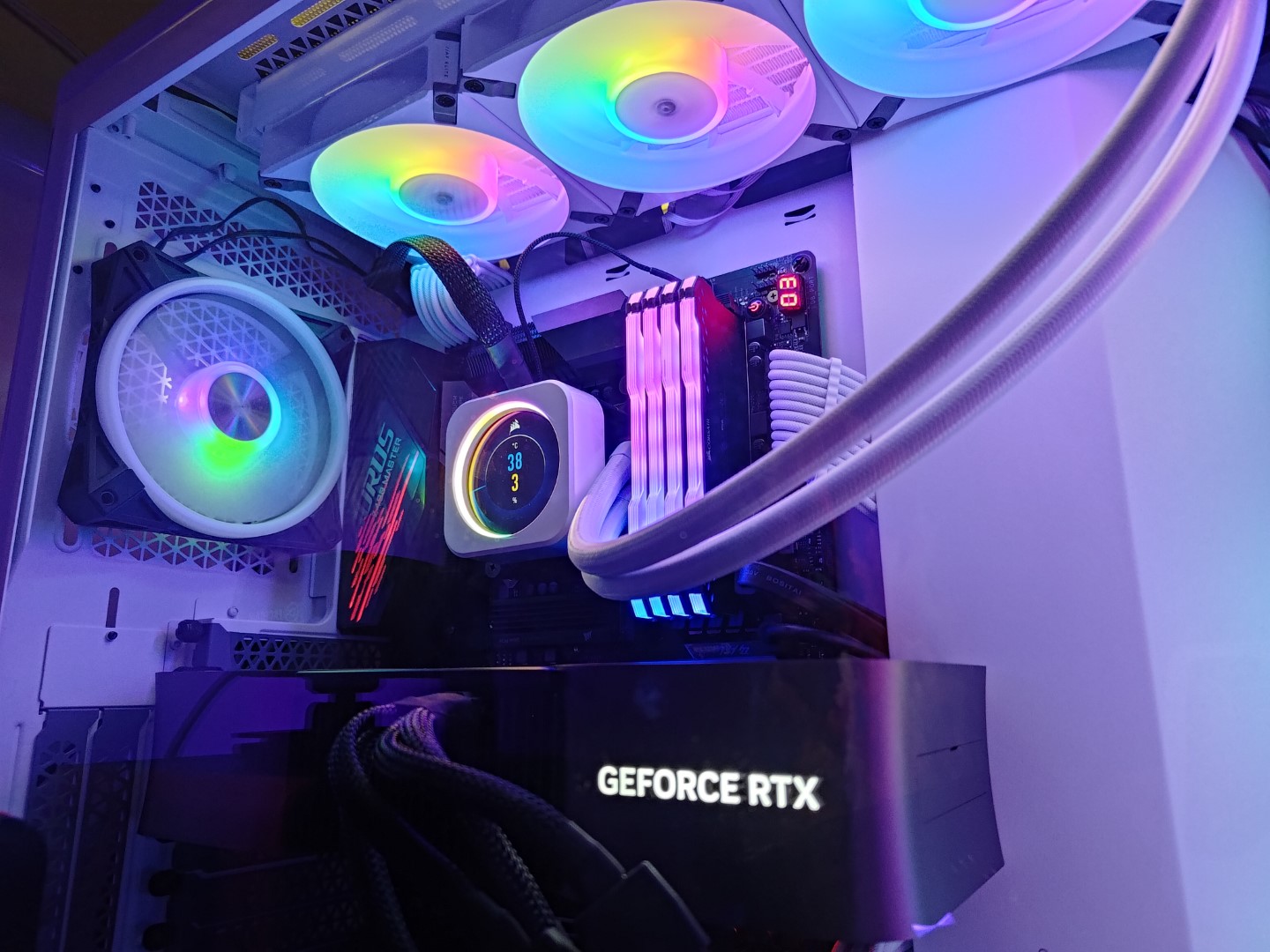
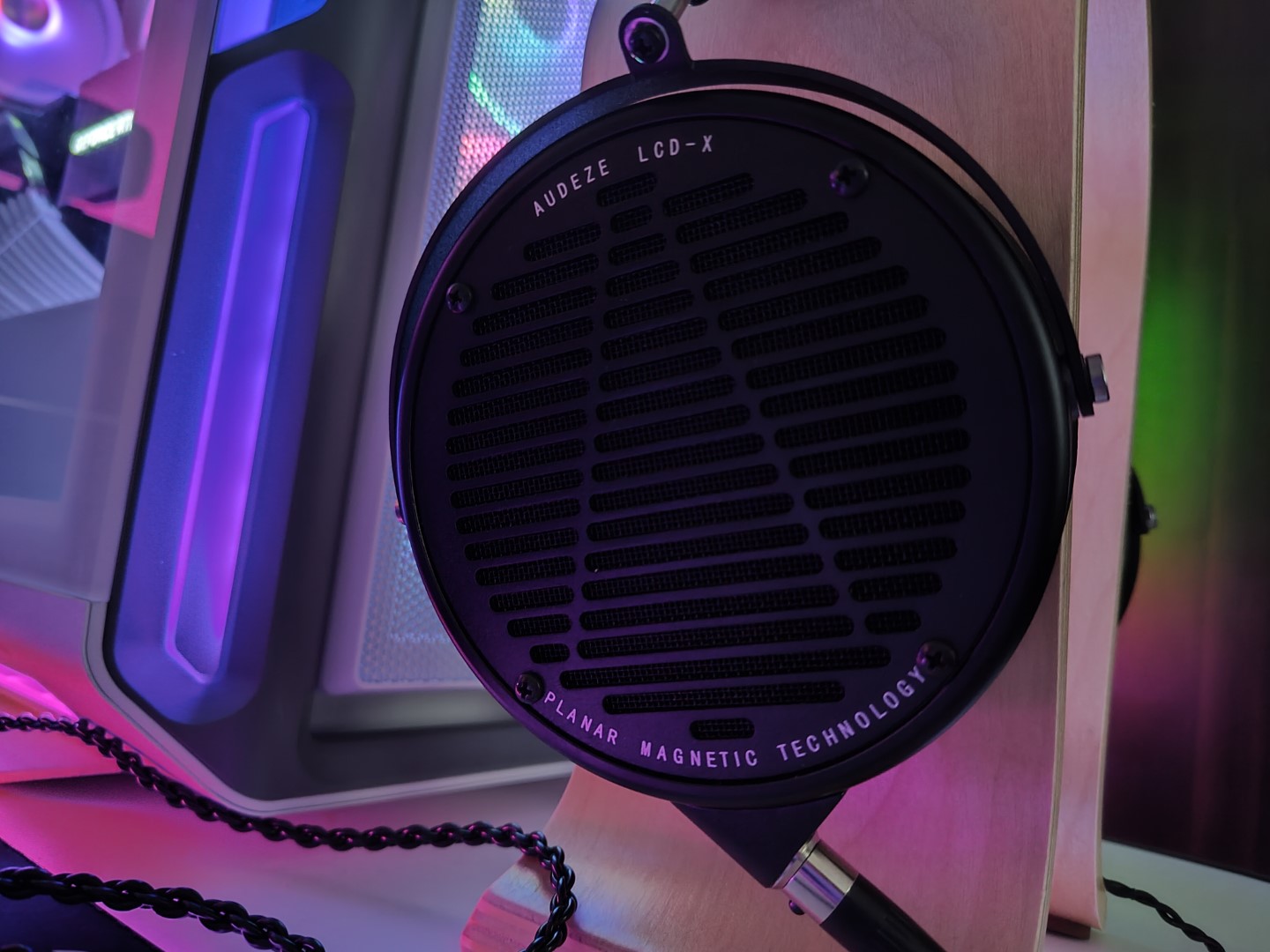




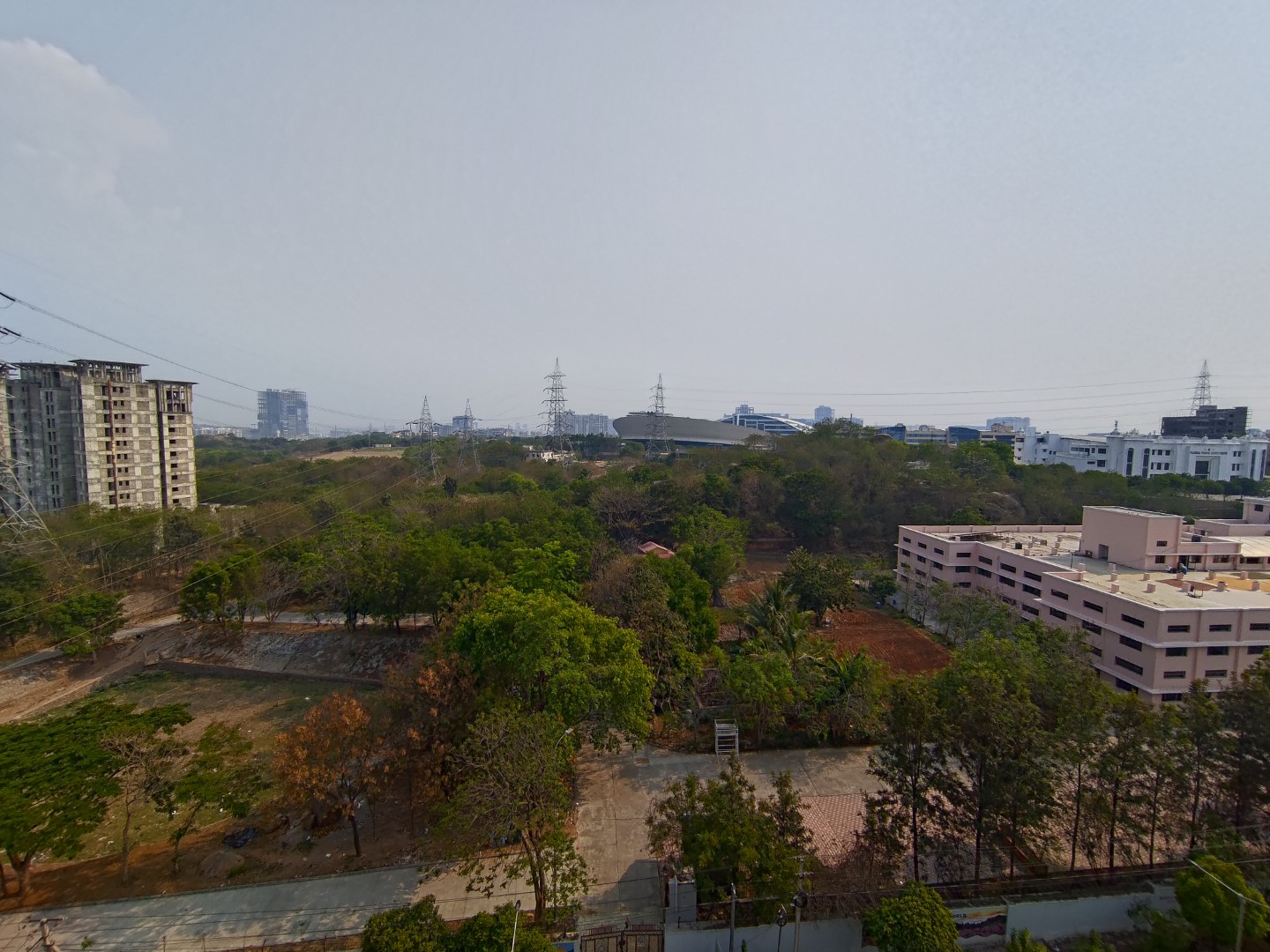
I used dozens of phones featuring the IMX766, and it does a decent job in any given lighting scenario. Shots taken in daylight have plenty of detail, good dynamic range, and high contrast levels. The shots aren't oversaturated but still look great, and noise is handled well.
The phone does a decent job in low-light scenarios as well, but you miss out on finer details. The dedicated Night mode does a slightly better job managing highlights and shadows, and while the camera package is much better than previous generations, it isn't quite on par with the likes of the S23 Ultra or the Pixel 7 Pro.
ASUS ROG Phone 7 Ultimate: Software
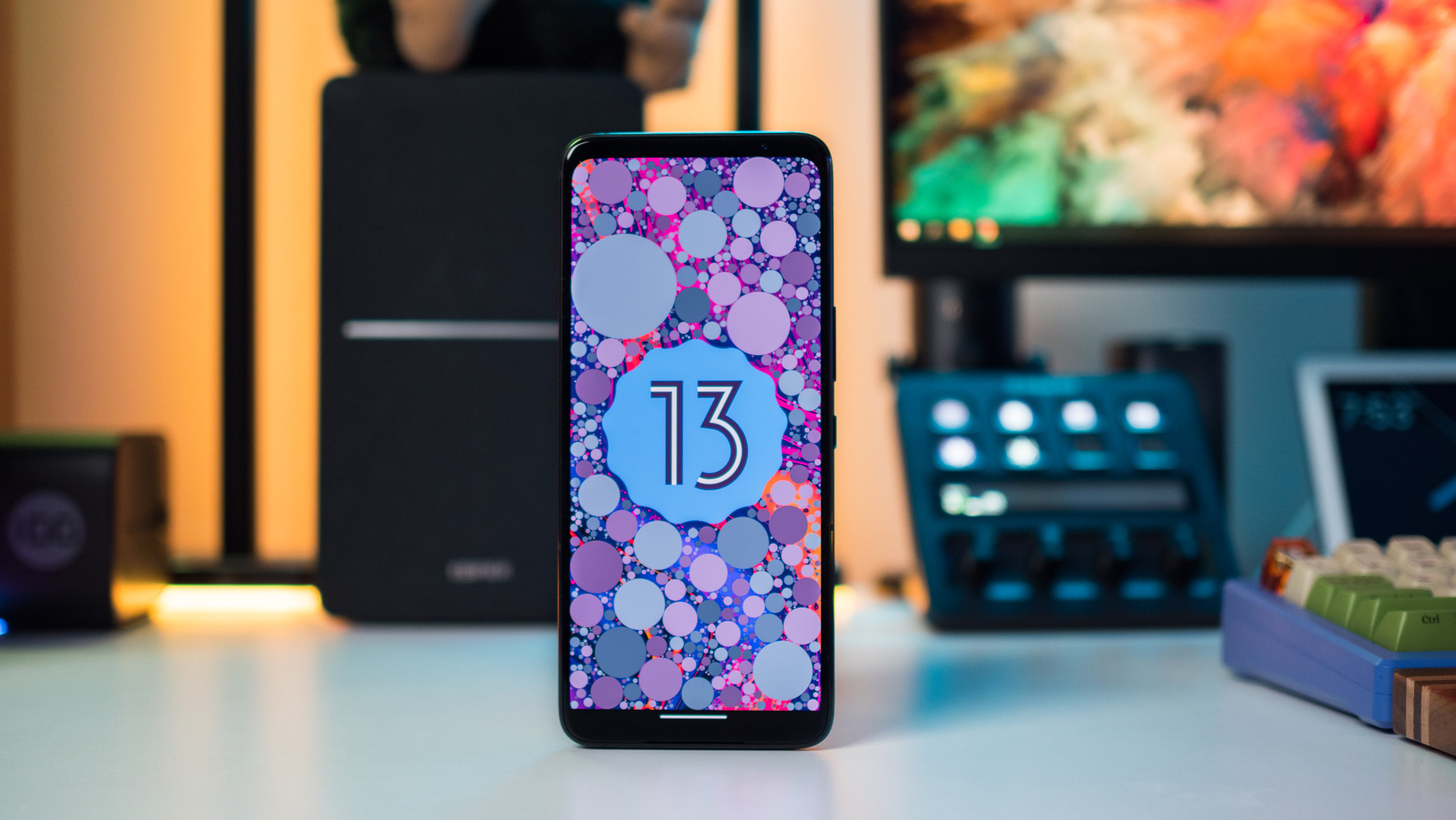
The hardware is obviously the biggest reason for buying the ROG Phone 7 Ultimate, but it's the software where ASUS truly differentiates its devices from other gaming phones. The Taiwanese brand offers an overwhelming set of customization options, and like previous years, that's a big part of the allure of the ROG Phone.
The default ROG UI has an aggressive styling that goes with the hardware, with plenty of red accents and customized backgrounds, notification shade, and effects. Thankfully, there's also the standard Zen UI interface, and this basically gives you a vanilla Android UI without any customization. What's new with this generation is that you get the ability to mix and match between the two; so if you like the backgrounds or icons available in the ROG UI, you'll be able to use those with Zen UI.
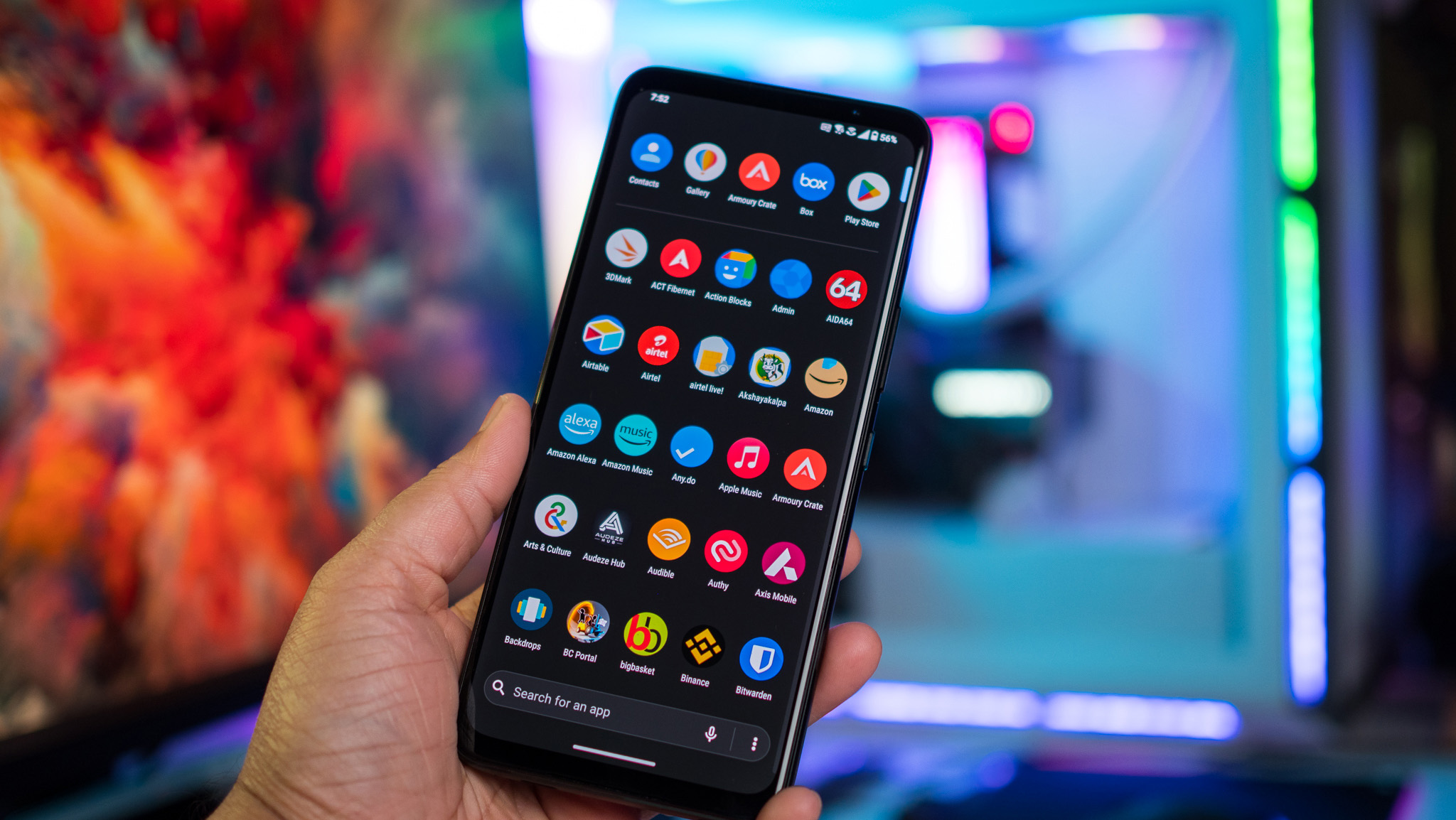
Armoury Crate is ASUS's gaming portal, and it gives you a high degree of customizability of just about every facet of the phone. You can view real-time thermals, change the performance mode as needed, set up lighting effects, adjust settings for individual games, and so much more. Honestly, the attention to detail that you get here is astonishing, and it's this granular control that gives ASUS's devices a distinct edge in the gaming category.
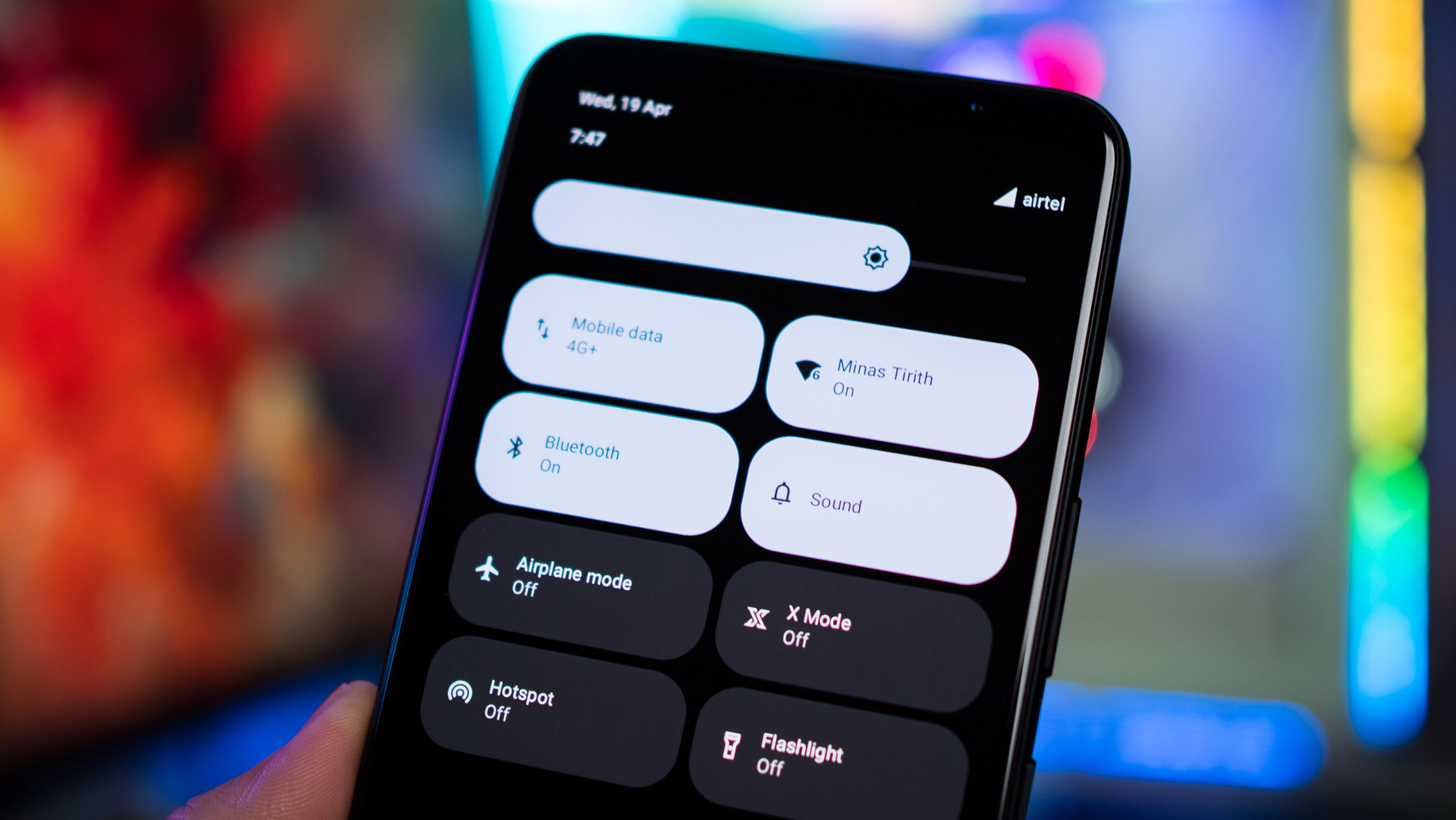
Furthermore, there are small things in the UI that I like. You can change the layout of the quick settings tiles in the notification shade; the large pill-sized tiles that debuted with Android 12 are enabled by default, but you can switch to the smaller tiles that were a mainstay on older versions of Android. There are a lot of customizable gestures, and off-screen gestures are intact as well.
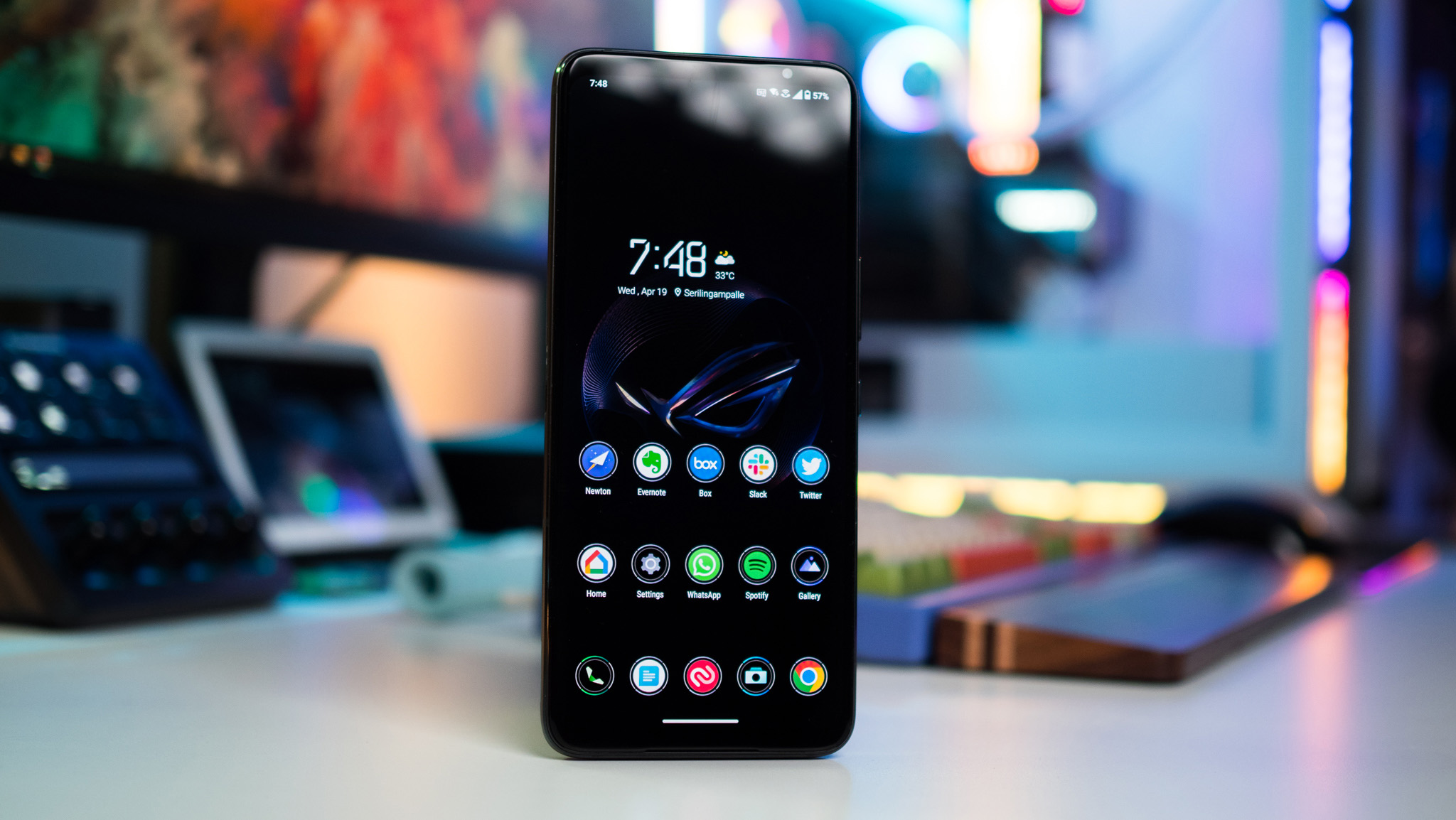
As for the software itself, the phone runs Android 13 out of the box, and ASUS guarantees two years of Android OS updates and four years of security updates. While more security updates are always welcome, I think ASUS should deliver at least three platform updates to the phone; most Android manufacturers now offer four Android OS updates as standard, and I can't help but feel that ASUS is lagging behind.
ASUS says it cannot deliver more than two platform updates owing to the sheer amount of customization it made to the Android kernel; this requires significant engineering resources whenever a new Android OS version is available.
ASUS ROG Phone 7 Ultimate: The competition
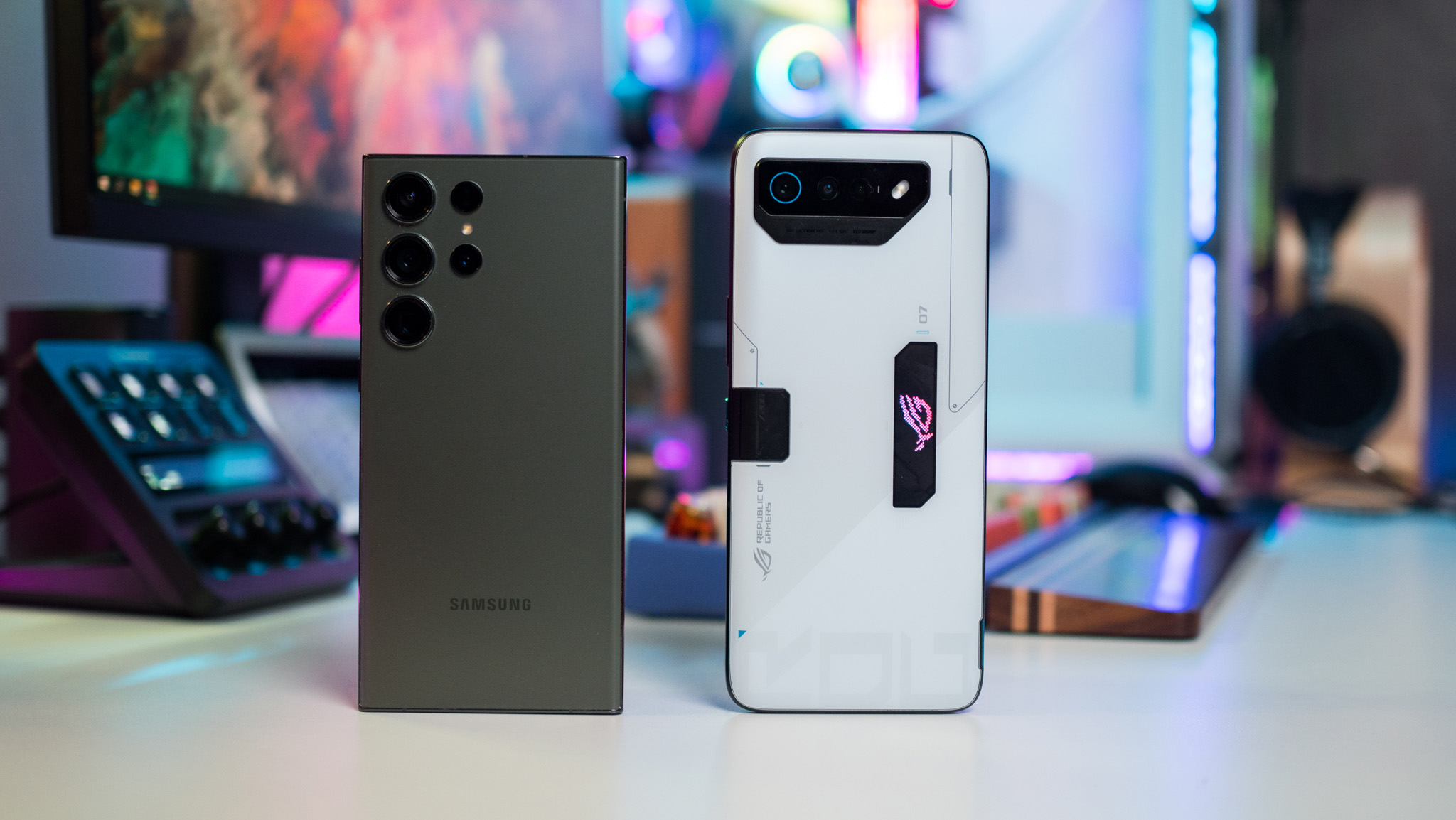
There's no shortage of flagship phones, and 2023 is proving to be a particularly good year for Android. If you want the best Android phone at the moment, my vote would be the Galaxy S23 Ultra — it has more features than just about any other device. The large 6.8-inch AMOLED screen is fantastic, the hardware is stellar, and it has one of the best camera packages available today. Samsung is also the frontrunner when it comes to software updates, and the S23 Ultra will get four Android OS updates — two more than what ASUS is offering.
If you need a cleaner interface, the Pixel 7 Pro is still a safe choice. Sure, it doesn't have a bold design and the hardware isn't quite on par with 2023 phones, but it has amazing cameras, and will receive updates ahead of other devices.
And if it's a gaming phone you're after, the Redmagic 8 Pro is a good alternative. You get excellent hardware for a lot less money than what ASUS is charging for the ROG Phone 7 Ultimate, but the software leaves a lot to be desired. If you need the best software and unique gaming-focused tweaks, ASUS is still the better bet.
ASUS ROG Phone 7 Ultimate: Should you buy it?
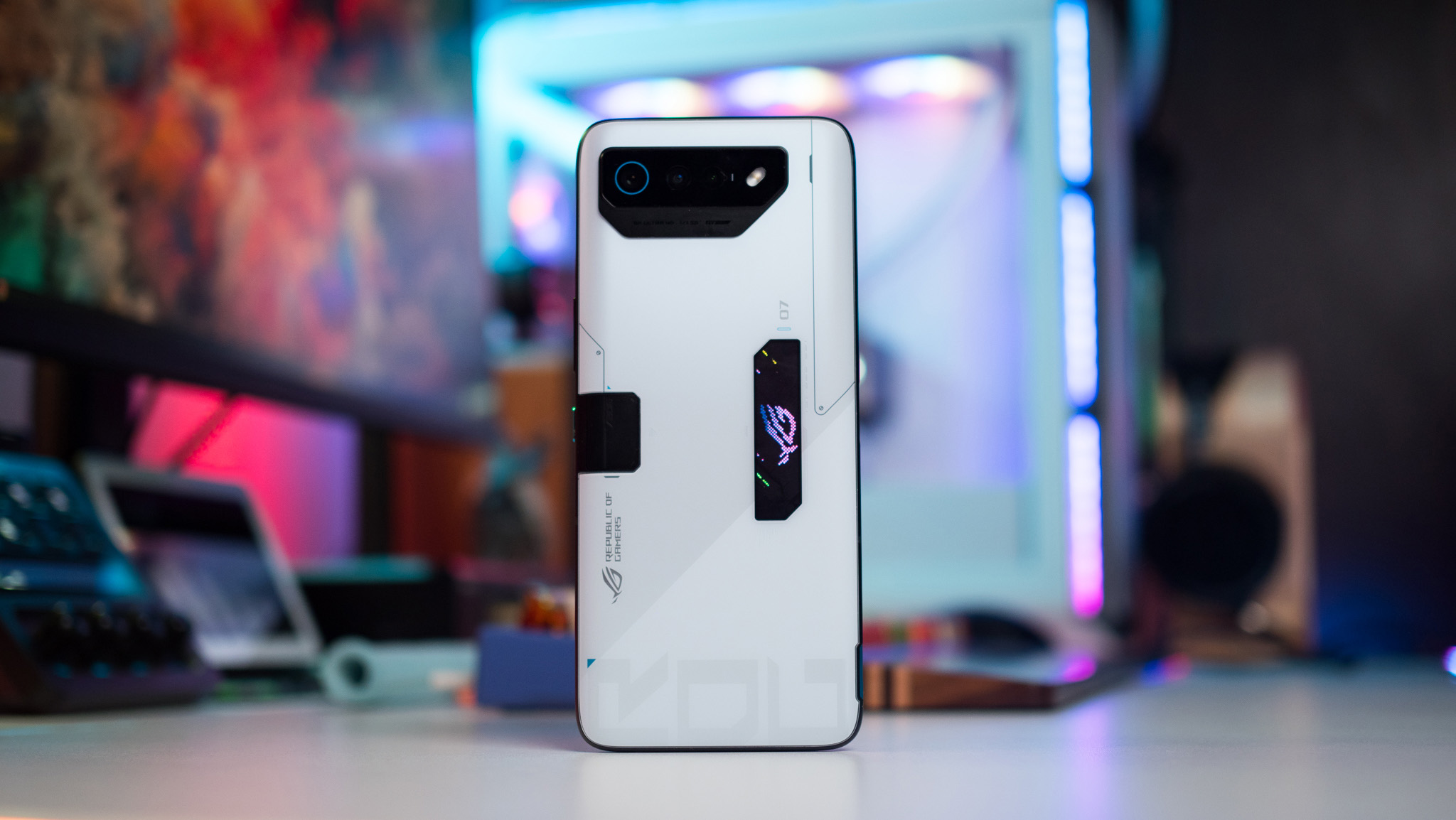
You should buy this if:
- You want the best gaming phone
- You need a phone with an aggressive design
- You want the latest connectivity and a 3.5mm jack
- You need the best battery life on a 2023 phone
- You want a clean Android interface with extensive customizability
You shouldn't buy this if:
- You need long-term software updates
- You're looking for versatile cameras
There's no question that the ROG Phone 7 Ultimate is the best gaming phone you can get your hands on at the moment. The hardware is just one part of that story; the bigger differentiator for the device is all the custom tweaks that ASUS added, and those go a long way in making it a phenomenal option for gaming.
ASUS did a terrific job with the ROG Phone series over the last five years, and it's no wonder that it is the leader in this category. The Taiwanese brand notes that ROG Phone users cumulatively logged 4 million hours of game time per week in 2022, and that clearly signals that there's a lot of interest in gaming-focused devices.
Thankfully, the ROG Phone 7 Ultimate doesn't differ too much to its predecessor, and that's a good thing. ASUS instead focused on making tweaks to the cooling system, thermal management, and software optimizations aimed at eking out the best possible framerates in demanding titles, and that makes a tangible difference in daily use.
There really isn't anything missing here; the ROG Phone 7 Ultimate has a fabulous 165Hz AMOLED screen, the hardware is among the best you'll find on Android, and unique additions like AirTriggers and extensive software customizability give it a distinct edge. The cameras are also much better than previous years, and while it's not as versatile as the likes of the Galaxy S23 Ultra, it is absolutely fine in most scenarios. The software also gets a lot right, and it continues to be one of my favorite Android interfaces.
Ultimately, my only quibble is that the phone won't get as many software updates as other Android flagships. I understand ASUS's justification, but there's no excuse to not offer at least three platform updates considering the hardware on offer. But other than that shortcoming, the ROG Phone 7 Ultimate is a fabulous overall showing, and it is a legitimate alternative to the best Android phones if you're in the market for a device that stands out.

Harish Jonnalagadda is Android Central's Senior Editor overseeing mobile coverage. In his current role, he leads the site's coverage of Chinese phone brands, networking products, and AV gear. He has been testing phones for over a decade, and has extensive experience in mobile hardware and the global semiconductor industry. Contact him on Twitter at @chunkynerd.
